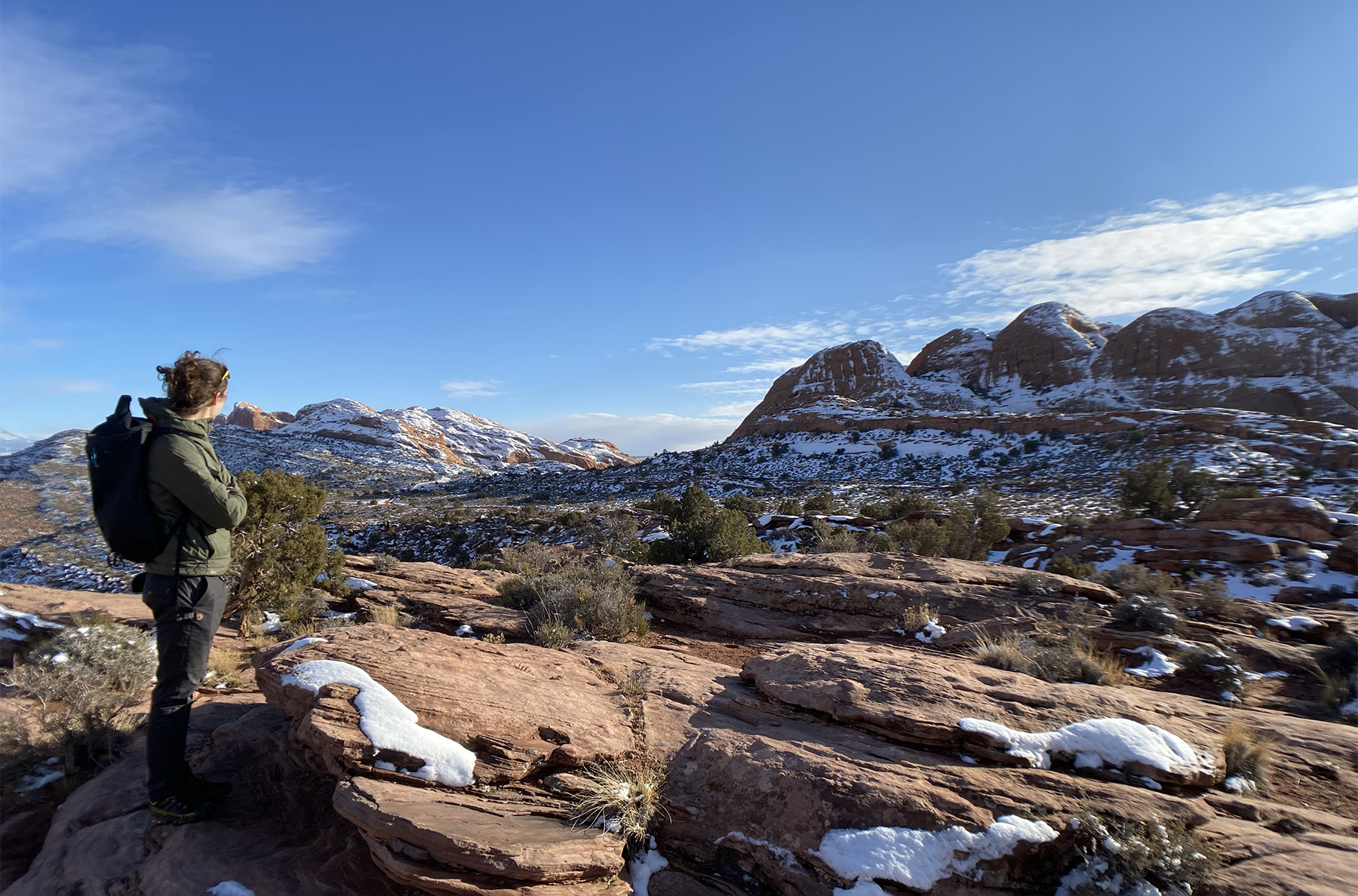
Intro
Whether it’s for skiing, biking, running, or any other activity, an ideal combination of base, mid, and outer layers can make your time outdoors a whole lot more — or less — enjoyable.
Midlayers and other insulators are a vital part of this, especially when it comes to balancing cold temperatures with high-output activities. As we’ve discussed in our Layering 101 article, we’ve now got a greater variety of layers to pick from than ever before, which is great in terms of having options, but it also means narrowing down all of them becomes trickier.
In this roundup, a bunch of our reviewers discuss a number of midlayers and other insulative layers that they’ve been using over the past 1-5+, outlining how each one stands out, what it does best, and where it might make sense to go with something else.
Here, we’ll be focusing primarily on newer and updated pieces that we haven’t yet discussed on our site, but for even more options, check out our Midlayer Roundup from 2022, and our other midlayer reviews
Outdoor Research Deviator Hoodie
MSRP: $229
Fabric: bluesign approved 90% nylon / 10% spandex shell (hood, shoulders, sleeves, front body); 95% polyester / 5% spandex (back body, side panels, under sleeve)
Insulation: 100% polyester VerticalX Octa
Measured Weight: 349 g
Size Tested: Men’s Medium
Reviewer: David Golay (6’, 170 lb / 183 cm, 77.1 kg)
We’ve never been proponents of updating gear just for the sake of change — rather, we frequently get nervous when companies start messing with pieces that we really like. The now-discontinued Outdoor Research Ascendant Hoodie was a longtime favorite of mine, and I’ve spent hundreds of days in my (now pretty tired) one over the years. But it turns out I needn’t have worried, because the newer Outdoor Research Deviator Hoodie that effectively replaced the Ascendant is improved in a few key ways while keeping most of what I liked about the Ascendant.
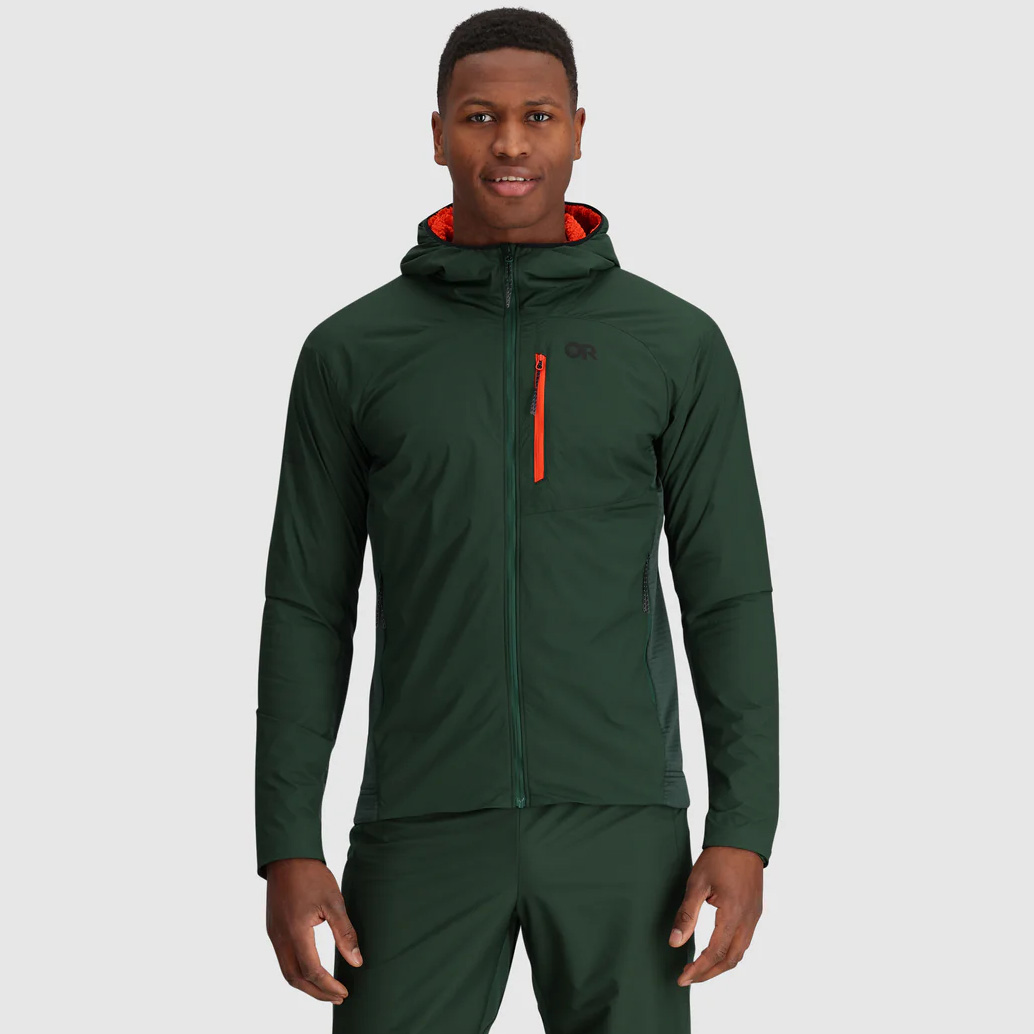
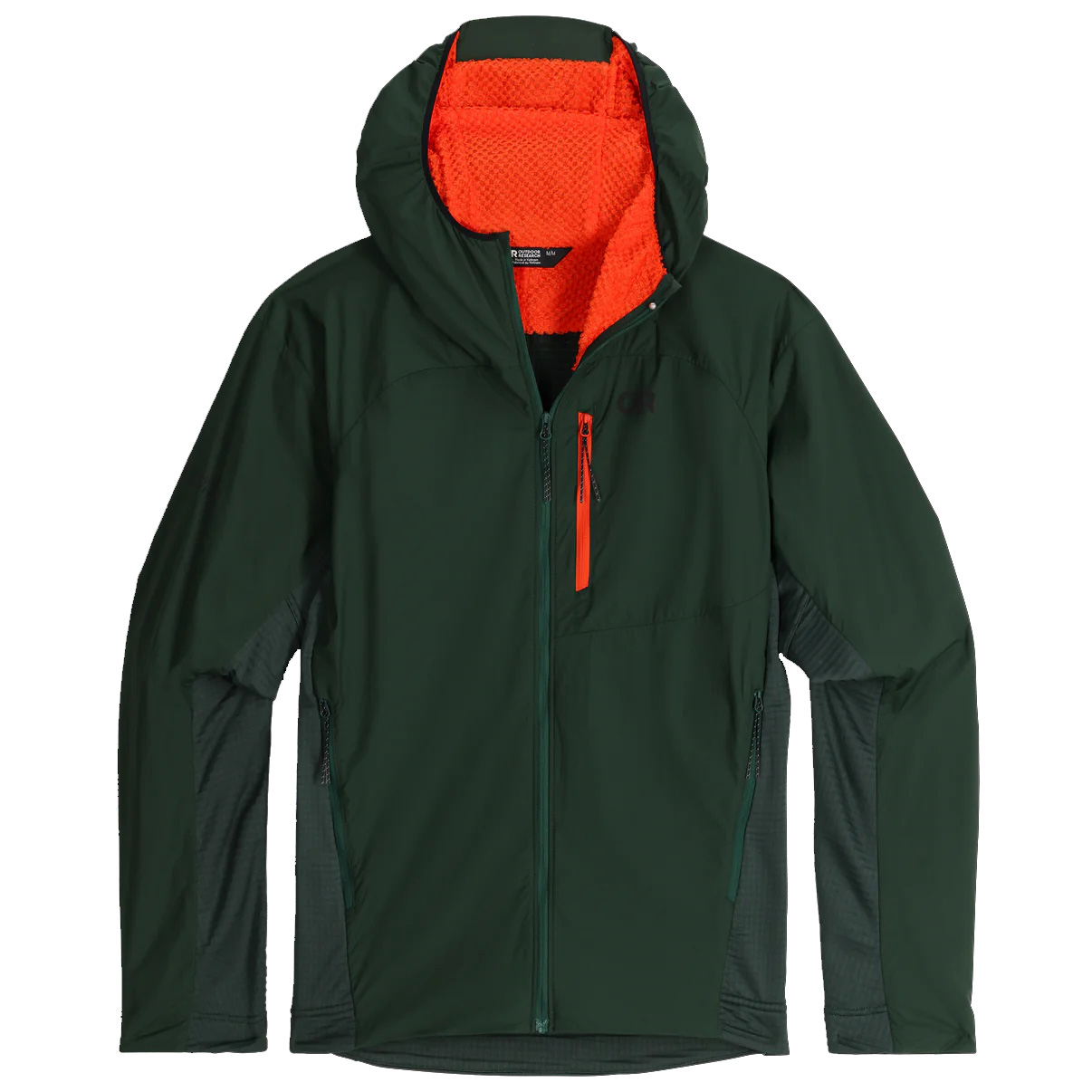
The overall concept of the Deviator is quite similar to that of the Ascendant — it combines a stretchy, slightly weather-resistant but highly breathable face fabric with lofted insulation on the inside to provide moderate warmth that breathes and regulates temperature well for high-output activities. Again like the old Ascendant, the Deviator gets a full zip closure, a pair of hand pockets (now zippered, in contrast to the open ones on the Ascendant), a single zippered chest pocket on the right side, and a medium-sized hood.
The two big differences between the two are their use of materials and their fit. The fabric and insulation used on the front of the body, top of the sleeves, shoulders, and hood of the Deviator is very, very similar to that of the Ascendant, but the Deviator subs in a second material with a more openly knit face and slightly lighter insulation for the back and undersides of the sleeves. That makes the Deviator slightly less warm, especially when being worn without a backpack, but quite a bit more breathable than the Ascendant, while being similarly weather-resistant in the areas where it’s most needed. While I’ve worn a Medium in both, the Deviator is quite a bit slimmer fitting through the body. For me, that makes for a better fit; the Ascendant always felt baggier than I needed it to be for a piece that I was rarely going to wear more than a baselayer under.
The Deviator’s combination of moderate warmth and weather resistance plus excellent breathability makes it work very well as a versatile layer for a lot of high-output activities in a wide range of weather conditions. It’s been my go-to for wearing as the outer layer for the ascent when ski touring (usually putting a shell over it for the way back down, unless temperatures are pretty warm). It’s also been an easy choice for some colder-weather bike rides, so long as conditions aren’t too wet, and some hiking and casual around-town use, too. While the Deviator is only slightly water-resistant, it does a pretty good job of staying warm even when saturated.
The changes to the fit are the only thing that would give me any pause in recommending the Deviator to folks who, like me, were big fans of the Ascendant and were sorry to see it go. If you’d prefer a slightly trimmer fit than the Ascendant (I’m in that camp, personally), the Deviator will be especially appealing. If not, you might want to size up, though the back panel is pretty damn stretchy, so it does a good job of not feeling super tight or restrictive despite the trimmer fit.
Patagonia Nano-Air Hoody
MSRP: $329 (on sale for $229 as of publishing)
Fabric: 1.6-oz 30D 100% recycled polyester air-permeable “shadow stretch ripstop”
Insulation: 60-g FullRange 100% polyester (93% recycled)
Measured Weight: 403 g
Size Tested: Men’s Medium
Reviewer: Luke Koppa (5’8”, 155 lbs / 173 cm, 70 kg)
Patagonia’s Nano-Air series has included several of our reference pieces in the “active insulation” category ever since Patagonia first launched them — an event that arguably helped launch the category into the mainstream.
This year, for the 2023-2024 season, Patagonia once again updated several of their Nano-Air pieces. The original Nano-Air Hoody, with its 60-g FullRange insulation, remains, but the rest of the line falls into the lighter, more breathable, less warm “Nano-Air Light” or “Nano-Air Light Hybrid” classifications (including a vest, jacket, and hoody in men’s and women’s sizing).
We’re hoping to test some of the new Nano-Air Light Hybrid pieces soon, but we’ve been big fans of past iterations — especially if you run on the warmer side and/or need a less-warm midlayer that breathes quite well.
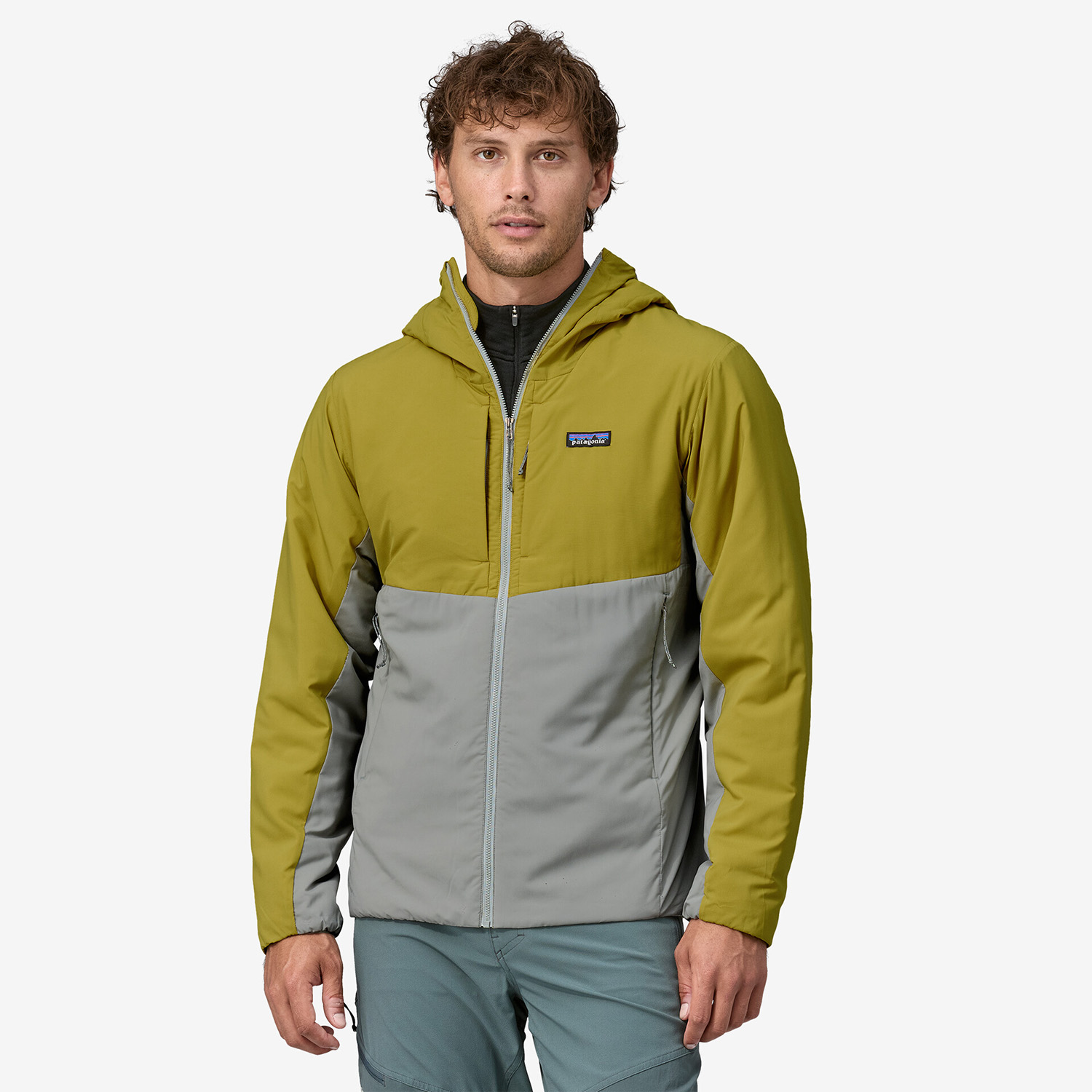

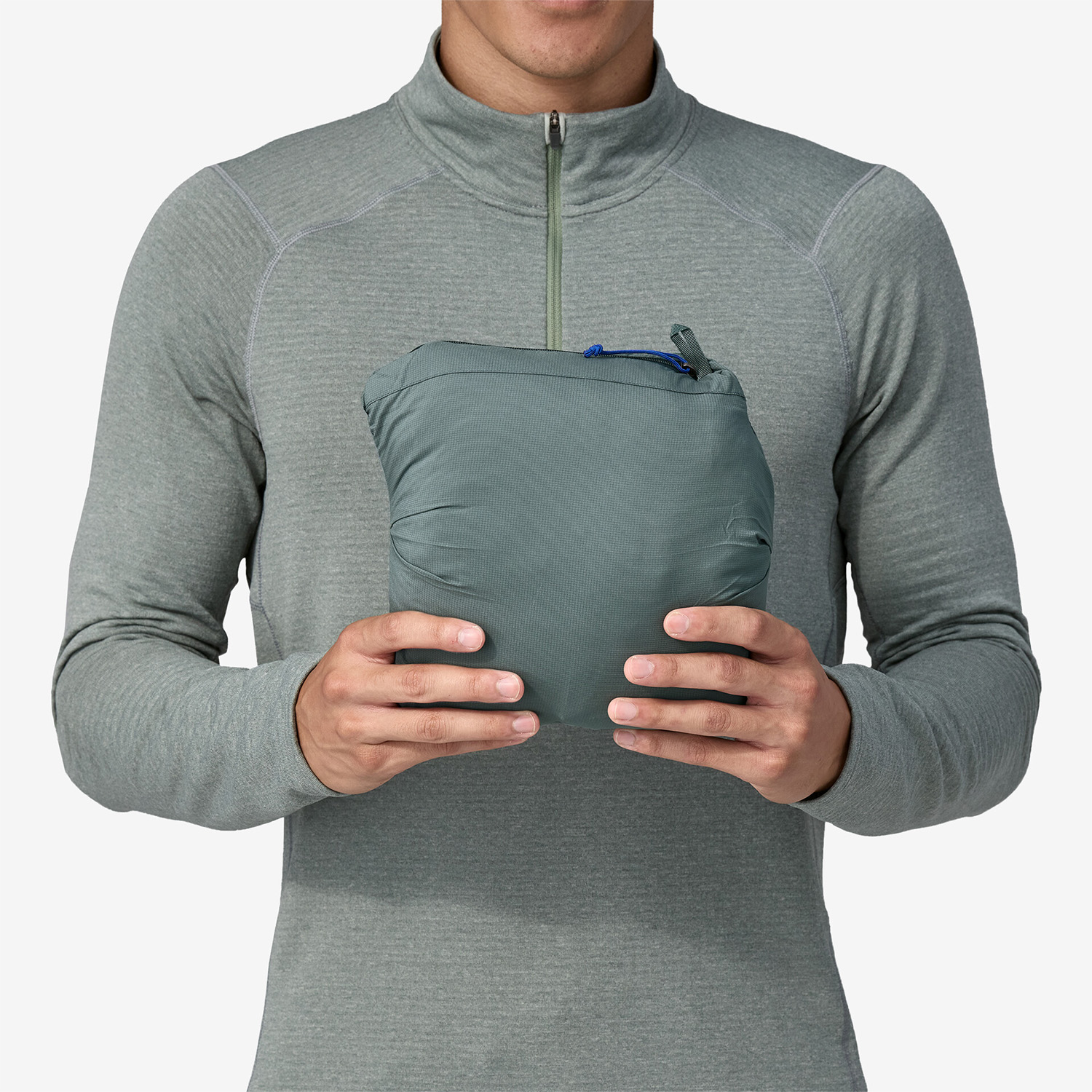
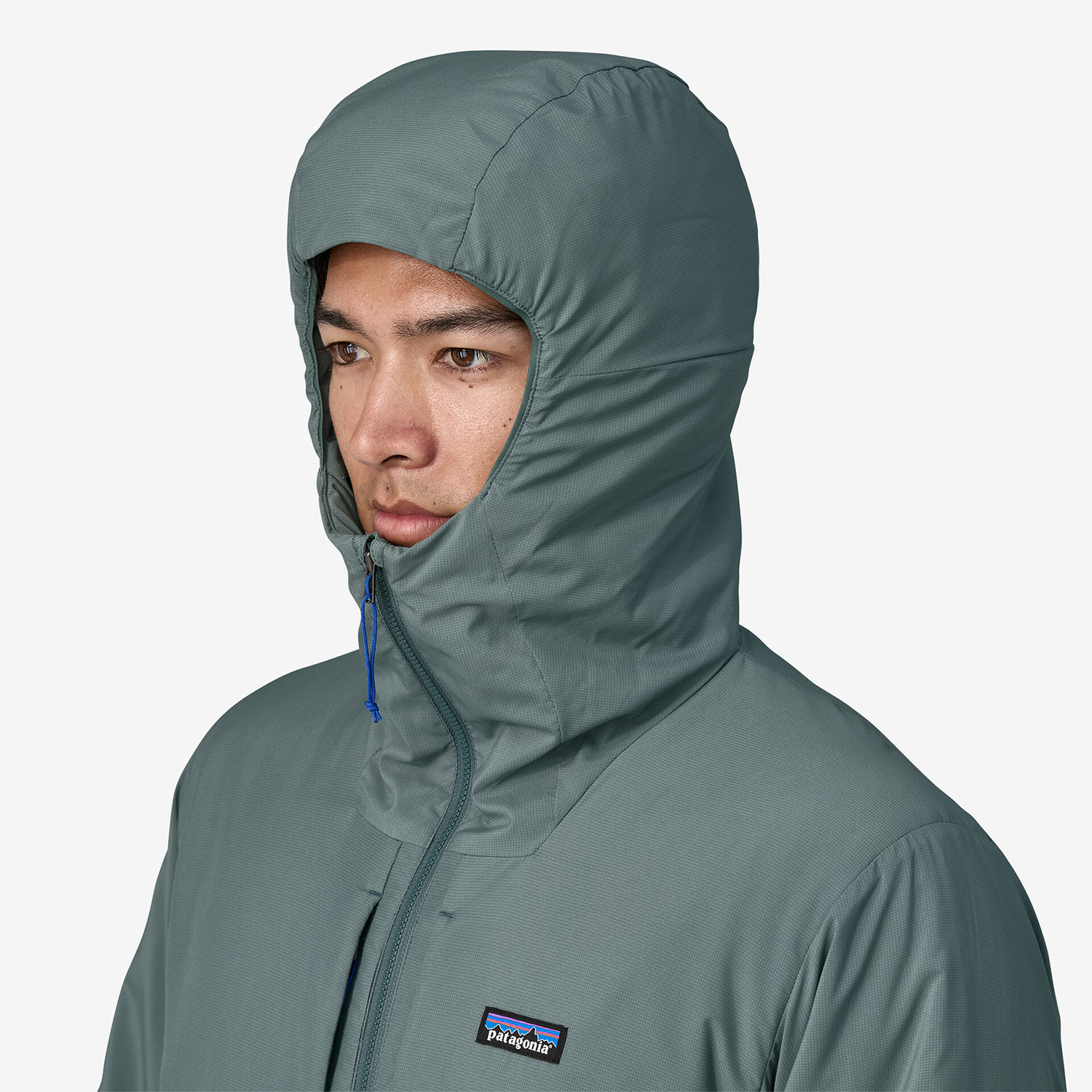
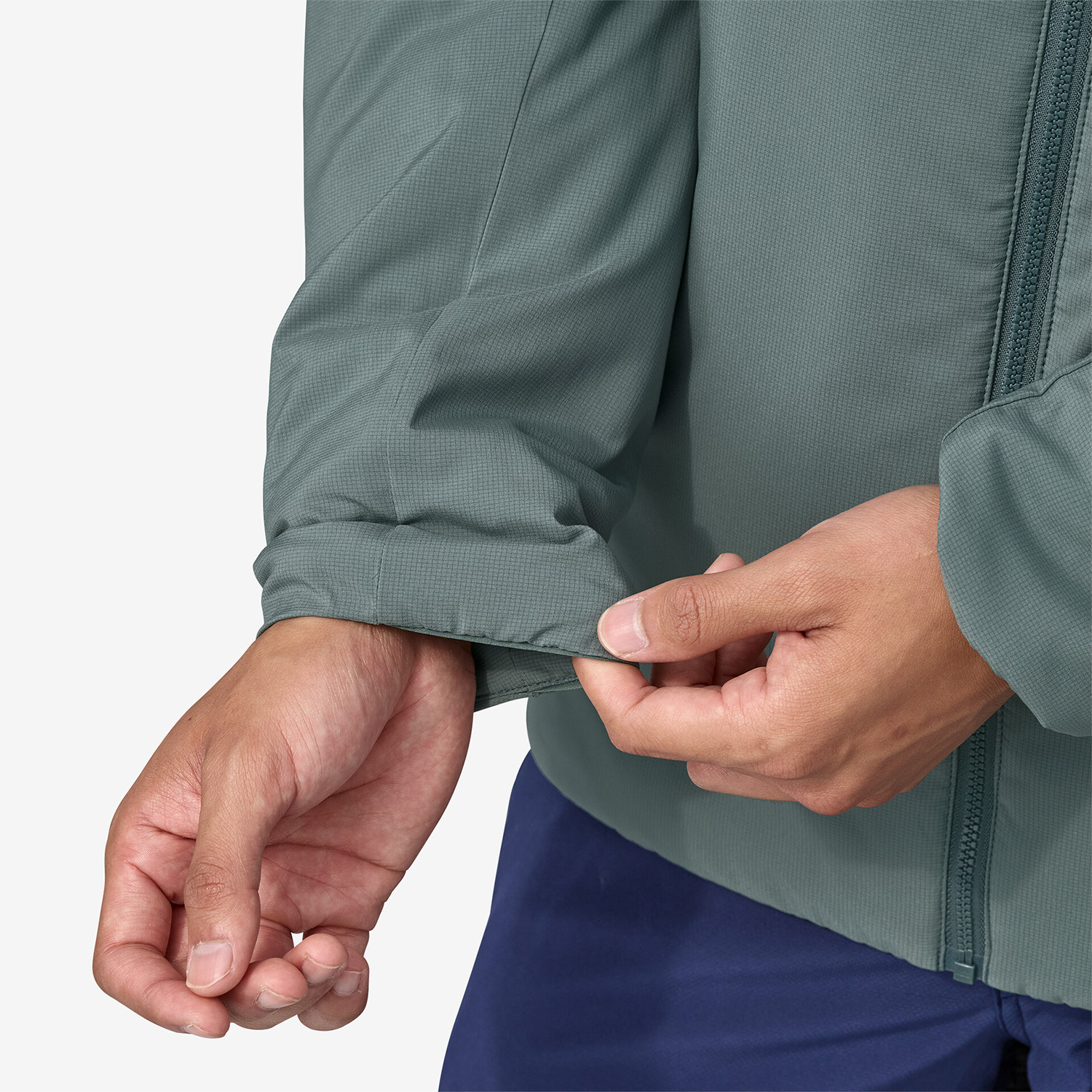
The new ones look very similar to past versions, with one of the big exceptions being a switch from the previous jacket’s thin, stretchy jersey fabric to Patagonia’s thicker, warmer, and still quite breathable “R1 Air” fleece in warmer areas like the sides, underarms, and back.
I prefer less-warm layers like the Nano-Air Light Hybrid for high-output activities such as ski touring, but the standard Nano-Air is still one of my all-time favorite midlayers for resort skiing. Like past versions, the current Nano-Air Hoody feels just about as warm under a shell (to me) as many traditional 60-g synthetic puffies and lightweight down jackets, but the Nano-Air keeps me comfortable in a much wider range of temperatures and output levels, since it doesn’t lock in all the heat and moisture my body builds up while skiing. I can typically be fine running a thin baselayer, the Nano-Air Hoody, and a shell throughout most of my resort ski season, in temperatures ranging from about 5°F (-15°C) to close to freezing.
That said, I personally run too hot to frequently wear the Nano-Air Hoody while skinning, unless it’s very cold (less than 10°F / -12°C); any warmer, and I’ll usually just skin in my baselayer, a non-waterproof softshell, and/or a really minimal insulator like the Patagonia R1 Air.
In terms of updates, the latest Nano-Air Hoody features a new, slightly more abrasion-resistant face fabric (100% recycled), more functional pockets and cuffs, and Patagonia has made their FullRange insulation 93% recycled. I still don’t really like the Nano-Air Hoody’s hood and neck — it feels too constrictive to me when fully zipped, though it does feel secure when layered under a helmet. I’m also bummed that Patagonia nixed the non-hooded, regular Nano-Air Jacket — I prefer a hoodless midlayer for resort skiing, since it makes for less bulk under my shell.
All that said, I’m glad to report that the latest Nano-Air Hoody is still one of the best all-round active insulators that I’ve used. It’s on the more warm / less breathable end of the spectrum in the current market, but it remains my all-time favorite resort midlayer. And the current version seems to be holding up better in the long run, thanks to a face fabric that works better when worn as an outer layer but doesn’t seem to compromise on breathability or comfort (it’s still absurdly comfortable).
Rab Vapour-Rise Summit Jacket
MSRP: $220
Face Fabric: 20D Pertex® Quantum Air
Fabric Lining: VR Warm fleece
Measured Weight: 321 g
Size Tested: Men’s Medium
Reviewer: Luke Koppa (5’8”, 155 lbs / 173 cm, 70 kg)
The Vapour-Rise series is Rab’s line of active-insulation layers, with the Vapour-Rise Summit using a Pertex Quantum Air face fabric for wind resistance and a low-density, high-loft fleece lining for warmth. We reviewed the Rab Alpha Flash jacket several years back and I figured the Vapour-Rise Summit used the same Polartec Alpha insulation as that jacket, but it’s apparently Rab’s proprietary “VR Warm” material; the VR Warm lining seems like it uses slightly shorter and maybe slightly denser fleece strands, but the goal seems similar — make insulation that’s highly breathable and warm.
I’ve really liked other midlayers that use similar open-knit fleeces and light face fabrics (e.g., Strafe’s old Alpha Insulator & Norrona Lyngen Alpha100 Zip Neck) for resort laps and cold days of touring. So far, the Vapour-Rise Summit is following that trend.


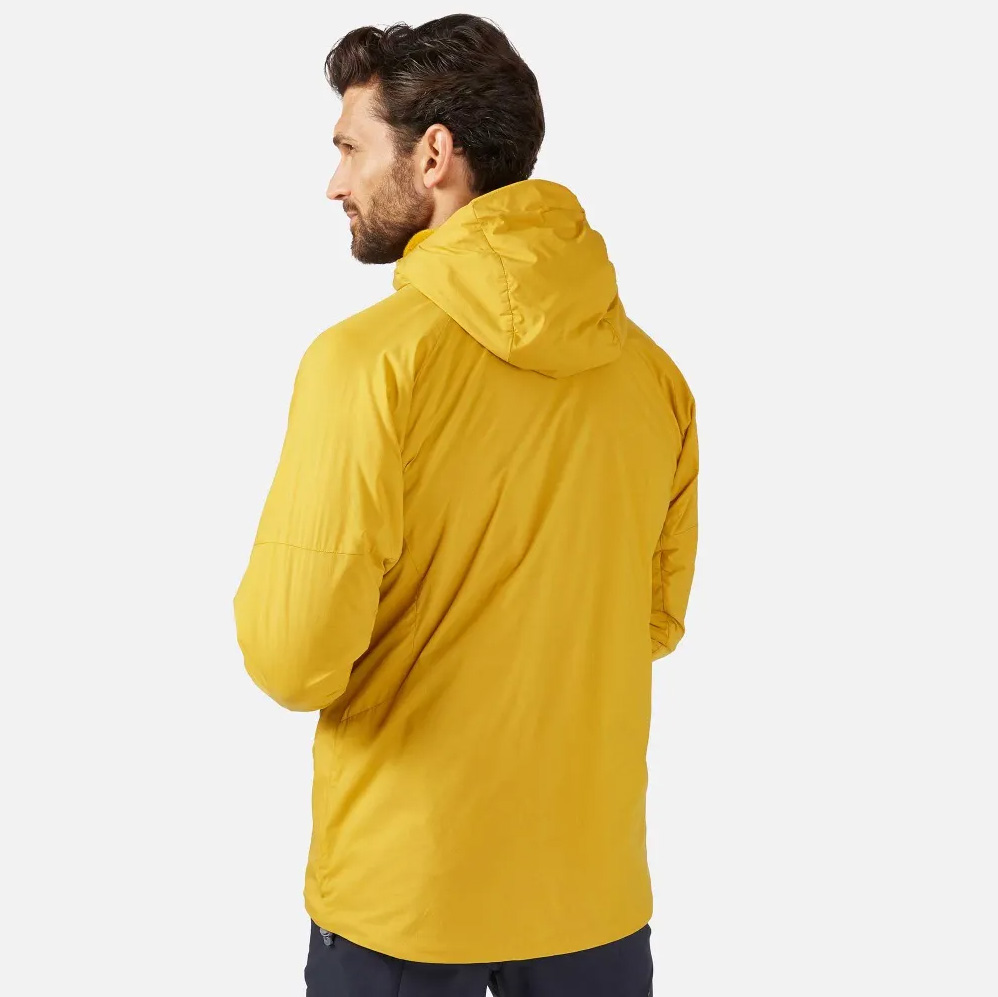
Similar to the Patagonia Nano-Air Hoody, the Vapour-Rise Summit is probably just a bit too warm for me when the temperatures get close to freezing, but colder than that, and it’s been very versatile under a shell.
Given its wind-resistant face fabric that still feels pretty breathable, the Vapour-Rise Summit has also been a pretty useful touring layer. It feels roughly on the same plane as the Nano-Air in terms of breathability; the Vapour-Rise Summit is probably a touch more breathable / less warm. Its slightly stiffer, more crinkly fabric also does a slightly better job of fending off moisture and wind, translating to slightly more versatility in a wider range of weather conditions.
I also think that the Vapour-Rise Summit looks very nice; I like that it has three zippered pockets; and I think its velcro wrist cuffs are probably not needed (though I also don’t really notice them under a shell). Its fit is pretty slim but somewhat long; a bit slimmer than an Arc’teryx Atom LT, but not by a huge margin. If you want a similar fabric composition in a roomier, more “standard” fit, see the Norrona Lyngen Alpha100 Zip Neck.
One of my only significant complaints about the Vapour-Rise Summit Jacket is its lack of odor resistance — even when I’m not working up a significant sweat (e.g., just walking up the hill to my place after work), it starts to stink more quickly than just about any other midlayer I currently use. Not the end of the world if you do your laundry more frequently than I do, but worth noting if you’re like me and like to (or just have to, due to laziness) keep your midlayer washings to a minimum.
Overall, the Vapour-Rise Summit makes for a versatile midlayer that blends some of the low weight and breathability of low-density fleeces like the Patagonia R1 Air with the weather resistance and outer-layer versatility of more traditional puffies. It compromises a bit on both ends, but the result is an adaptable layer.
Patagonia R1 Air Hoody
Patagonia R1 Air Hoody
MSRP: $179
Fabric: 5.7-oz 100% recycled polyester jacquard fleece w/ hollow-core yarns
Stated Weight: 366 g
Size Tested: Medium
Reviewer: Luke Koppa (5’8”, 155 lbs / 173 cm, 70 kg)
At this point, the Patagonia R1 is one of the most famous and longstanding jackets in the outdoor world. The original version, still available in its latest form, is a grid-fleece jacket that stands out for its breathability. Patagonia has since expanded the “R” series, with one of the most recent additions being the R1 Air collection. These midlayers still stand out for their breathability, but they’re a lot warmer and loftier than the standard R1.
The R1 Air Hoody features a zig-zag fleece knit that reportedly uses hollow-core yarns of 100% recycled polyester. What that translates to is a very soft and very light fabric that provides an impressive level of warmth while maintaining very good breathability. I’d put the R1 Air fabric roughly in the same class as Polartec Alpha and the fleece used on the Rab Vapour-Rise Summit Jacket — i.e., high-loft, open-knit, lightweight fleeces.
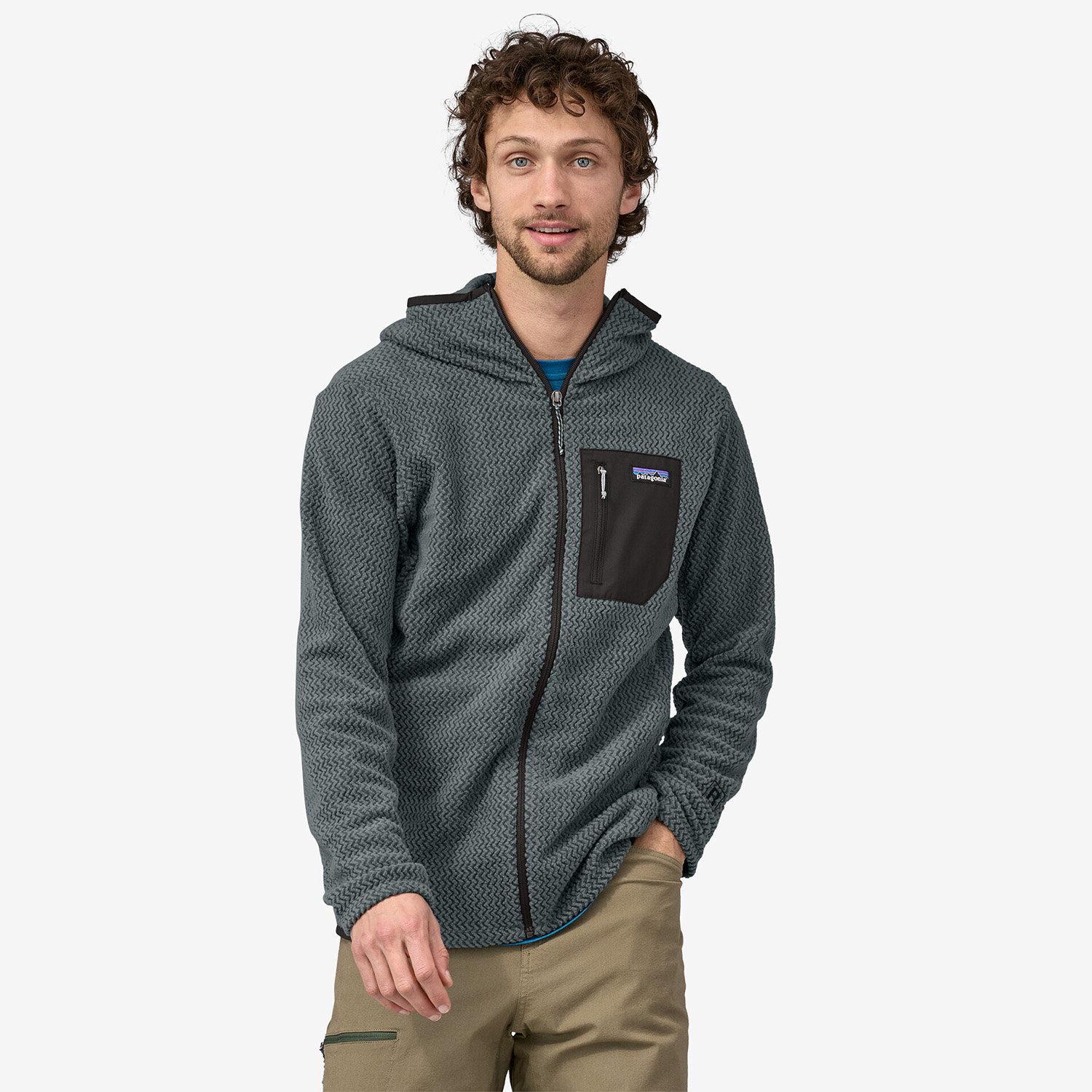
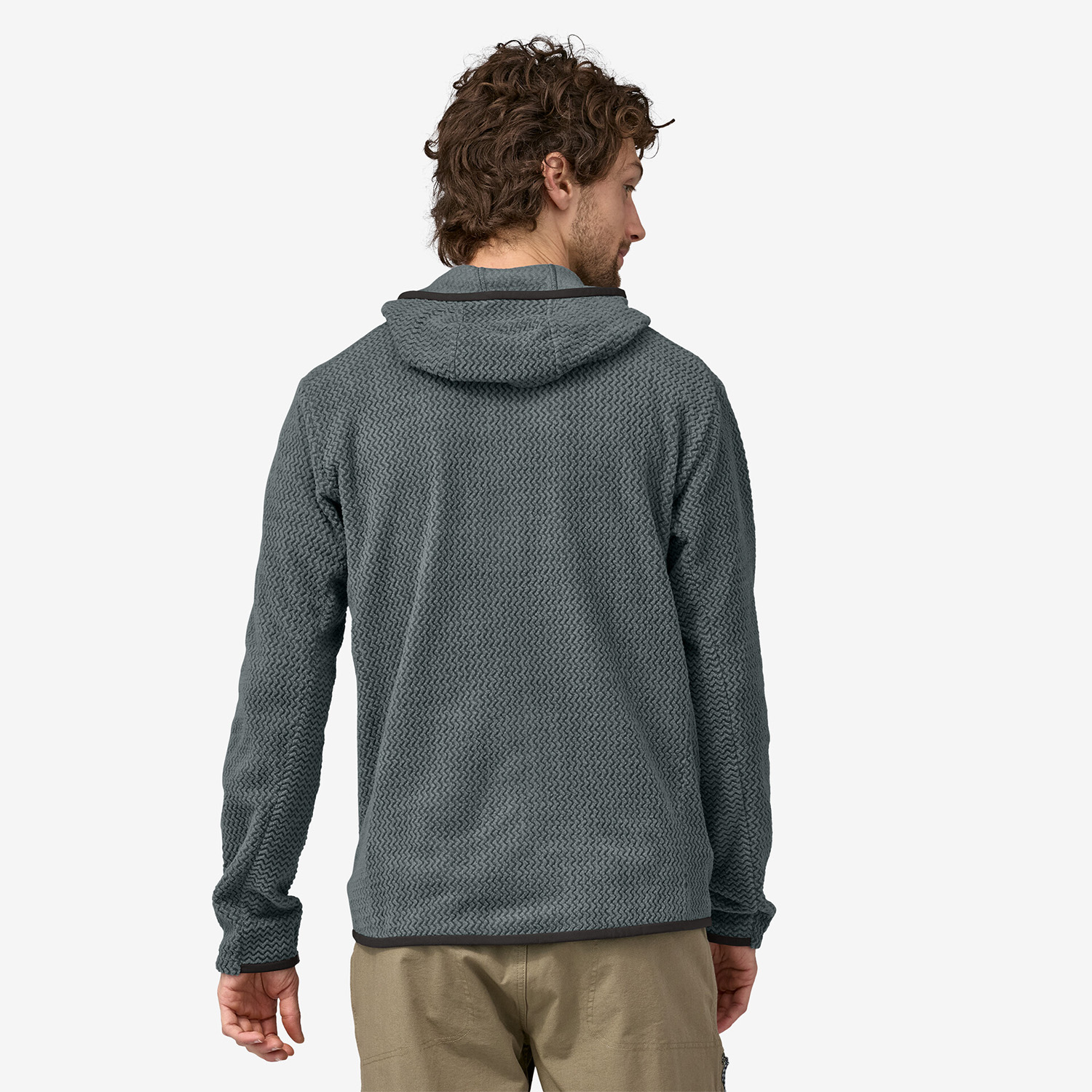
The upside to this is better warmth-to-weight ratios than the denser fleeces of old, and a reduction in overheating when you’re working up a sweat. The downside is reduced weather protection, especially compared to denser-knit, “hardface” fabrics like the Patagonia “TechFace” series, or midlayers that feature a separate, woven face fabric (e.g., Rab Vapour-Rise Summit & Norrona Alpha100 Zip Hood).
Given that, we primarily like to use the R1 Air (1) on its own in non-windy, non-wet conditions, or (2) under a shell. It provides very little wind or water resistance, which can be great when working hard in dry, cold scenarios, but it’s probably most useful as an under-shell midlayer. In that latter situation, it provides impressive warmth for being a pretty thin fleece jacket, while also breathing a lot better (and therefore being more versatile across more temperatures) than most batted-insulation “puffy” jackets. The R1 Air falls on the less-warm end of the spectrum for the layers here, but it’s still quite useful in many scenarios, including shoulder-season use.
For a similarly warm, slightly less breathable, and notably more weather-resistance alternative, check out the Patagonia R2 TechFace Jacket.
Patagonia DAS Light Hoody
MSRP: $349 (on sale for $243 as of publishing)
Shell Fabric: Pertex Quantum Pro (10D NetPlus 100% recycled nylon ripstop w/ PU & PFC-free DWR coatings)
Lining: Pertex Quantum (10D 100% recycled nylon ripstop)
Insulation: 65-g PlumaFill (100% recycled polyester)
Measured Weight: 331 g
Size Tested: Men’s Medium
Reviewer: Luke Koppa (5’8”, 155 lbs / 173 cm, 70 kg)
Similar to how the Patagonia Nano-Air series has become a reference point for the active insulation category, their “PlumaFill” insulation has earned a similar title when it comes to lightweight, warm-for-the-weight synthetic insulations. That insulation first debuted on the Patagonia Micro Puff Hoody, but my current favorite piece that utilizes it is the DAS Light Hoody.
The DAS Light Hoody is basically a slightly harder-wearing, more weather resistant, and warmer version of the Micro Puff Hoody. The DAS Light uses similar fabrics and insulation, but it adds a PU finish to its face fabric and that face fabric is an additional, separate layer (rather than having sewn-through baffling, like many puffy midlayers).
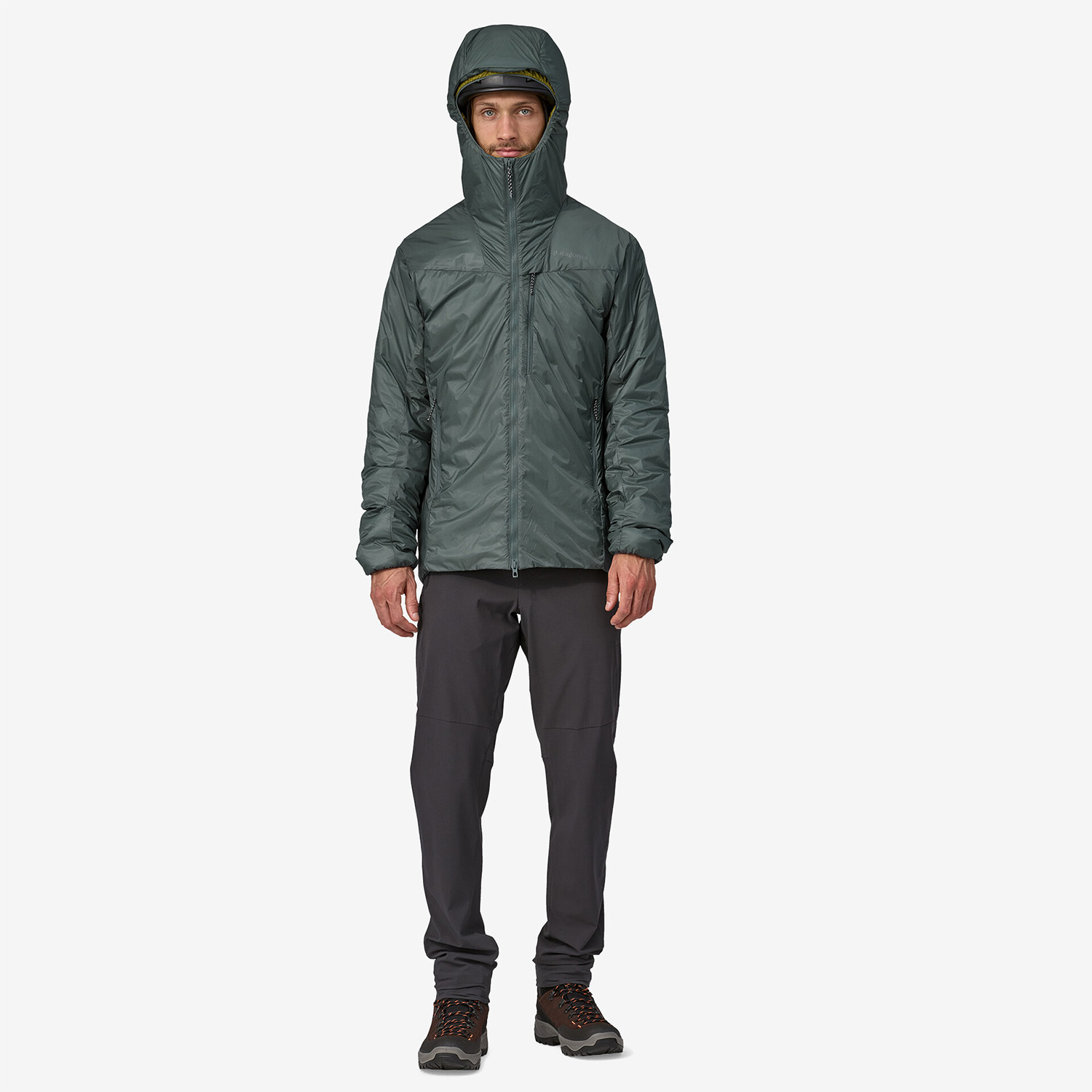
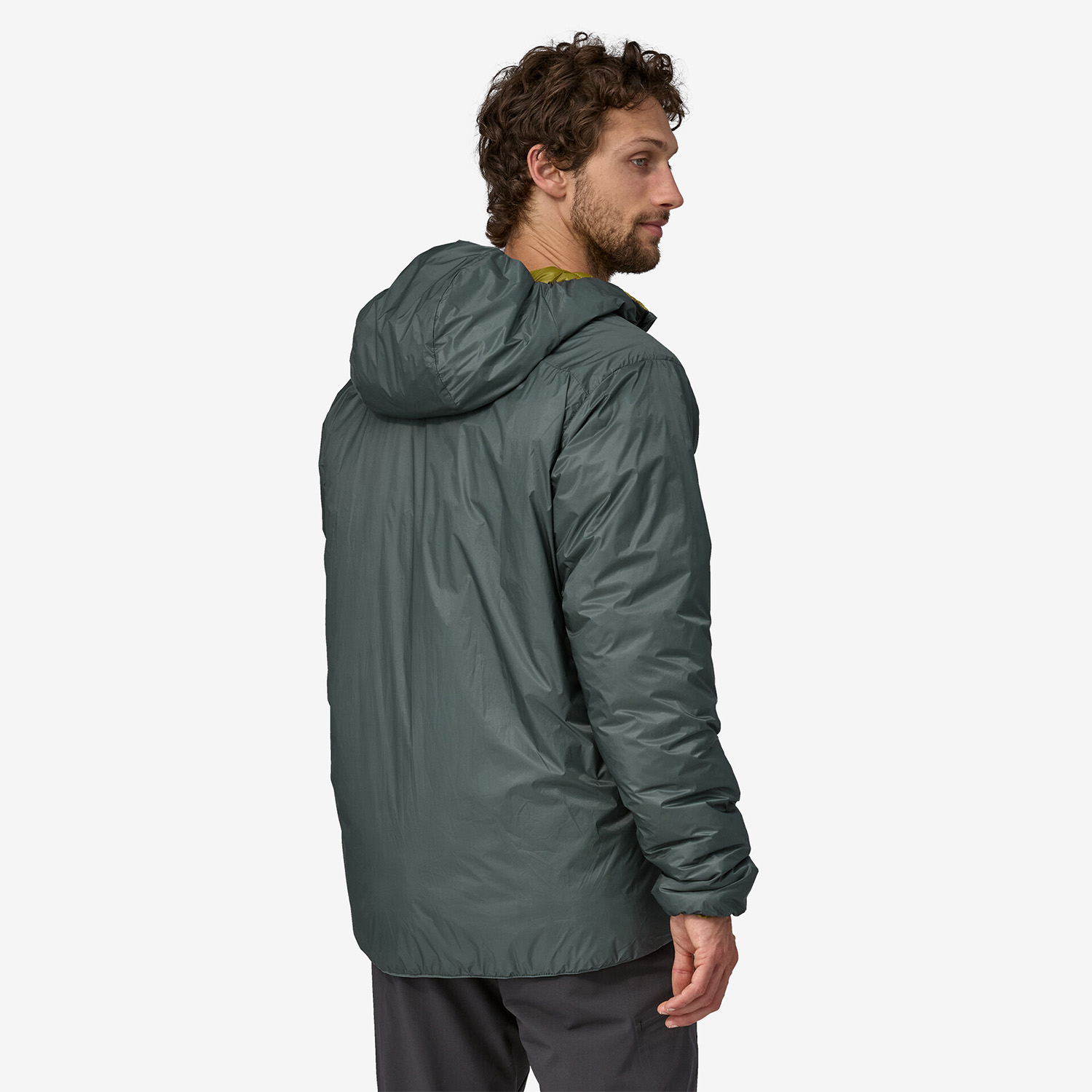
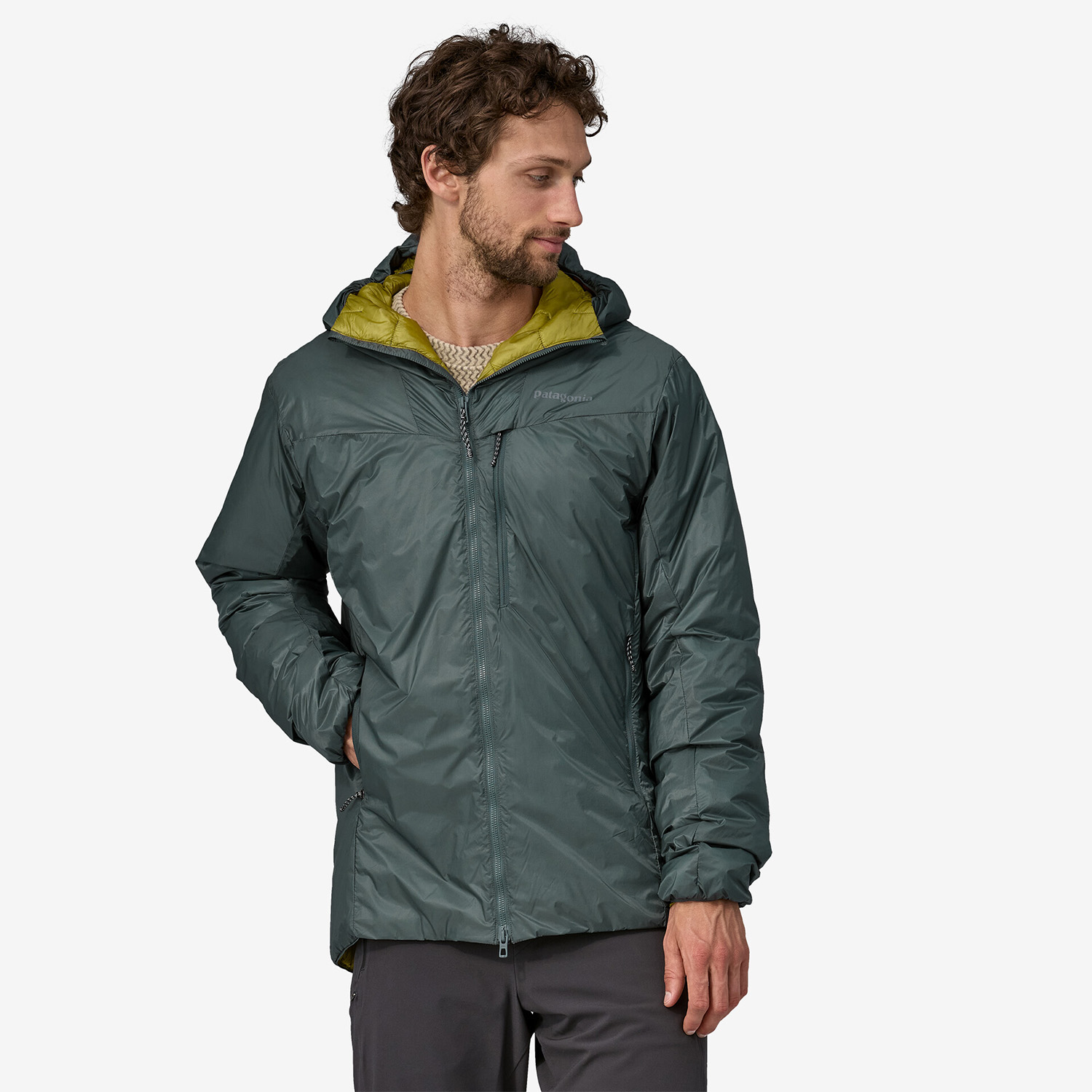
The former aspect makes it notably more water resistant and seems to reduce snagging on things like branches, while the latter adds just a touch of warmth and wind resistance.
The DAS Light is also cut a bit roomier than the Micro Puff and comes with more features: an exterior chest pocket and an adjustable, over-the-helmet hood.
All of this makes the DAS Light a better option than the Micro Puff if you’re looking to frequently use this layer as your outermost jacket. It doesn’t layer quite as well under a shell, but the DAS Light has become one of my go-to insulators to keep in my touring pack and pull out at transitions and often use as my outer jacket on the ski down. I rarely skin uphill in my midlayers, due to my tendency to overheat, so the DAS Light has been a much more common companion for me in the backcountry, instead of more breathable but less warm and less weather-resistant layers like the Patagonia Nano-Air.
I’ll opt for the much, much bulkier and warmer DAS Parka if I know I’ll be sitting in the cold for extended periods of time, but the DAS Light has been ideal for when I don’t need a full-on belay parka but want a very packable, quite warm, and weather-resistant insulator.
Outdoor Research Superstrand LT Hoodie
MSRP: $235
Fabric: 12D 100% nylon ripstop
Insulation: VerticalX SuperStrand (100% polyester)
Measured Weight: 305 g
Size Tested: Men’s Medium
Reviewer: Luke Koppa (5’8”, 155 lbs / 173 cm, 70 kg)
Up until this past fall, no synthetic insulation we had used could legitimately compete with Patagonia’s PlumaFill when it came to warmth-to-weight ratio and feeling so similar to down. Outdoor Research’s new VerticalX SuperStrand insulation changed that.
Of the midlayers we’ve used, the SuperStrand LT Hoody is the strongest competitor to the Patagonia Micro Puff Hoody — they’re both exceptional when it comes to nearly matching high-end down from a warmth-to-weight ratio, while still offering decent insulative value when wet. And once I looked into the VerticalX SuperStrand insulation, that made sense.
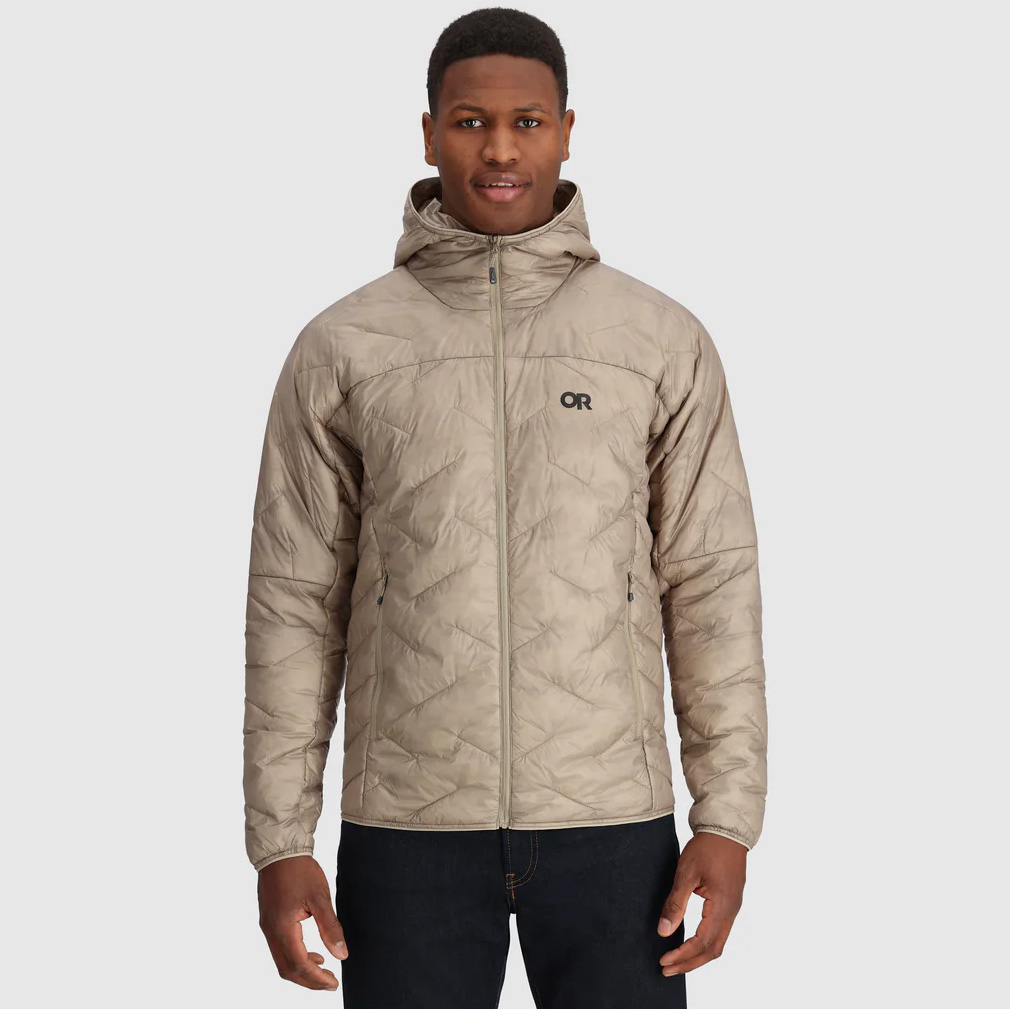

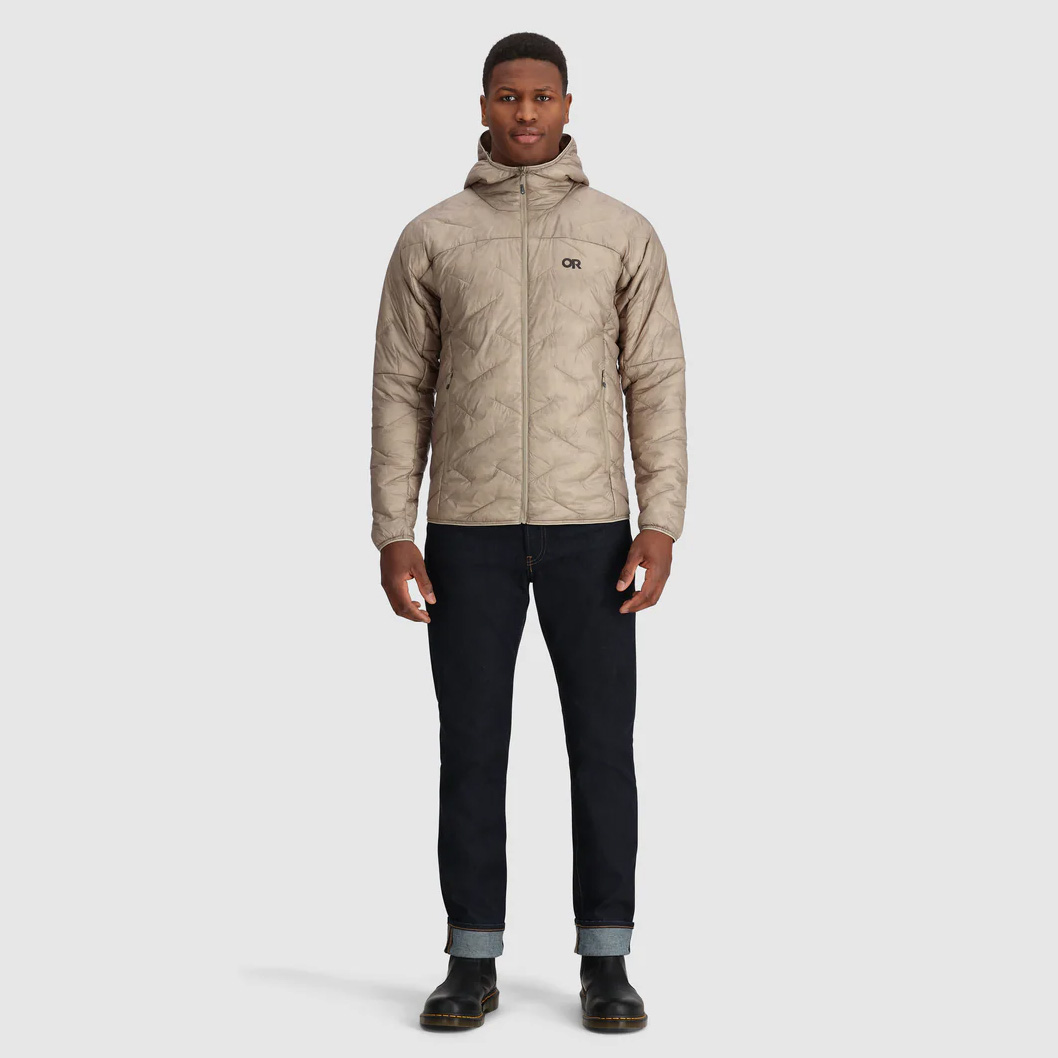
Most synthetic insulations are constructed in sheets of batted material, like you’d get in a synthetic comforter. But both SuperStrand and PlumaFill consist of continuous polyester fibers that have tons of smaller fibers protruding from them; visually and physically, the result is something that looks very much like a long string of down fibers. I.e., way fluffier and lower density than batted insulation. I’d wager they’re manufactured in a very, very similar manner.
Proprietary tech suspicions aside, the main point is that the SuperStrand LT Hoody feels and performs a heck of a lot like the Micro Puff Hoody. And that’s great — they’re both very light, very packable, and very warm, relative to those two latter aspects. And they both still insulate pretty well when they’re wet.
They also share nearly identical feature sets: two zippered hand pockets, two drop-in interior pockets, elastic under-helmet hood, and elastic cuffs. The Micro Puff adds a cinchable hem. They fit pretty similarly, too, though the SuperStrand LT Hoody’s sleeves are a bit shorter.
One big difference? The price — the SuperStrand LT is almost $100 less expensive, and is a great alternative to the Micro Puff if you like the sound of lightweight, highly packable synthetic insulation but the Micro Puff’s price tag seems a bit high.
Patagonia DAS Parka
MSRP: $449 (on sale for $313 as of publishing)
Shell Fabric: Pertex Quantum Pro (10D NetPlus 100% recycled nylon ripstop w/ PU & PFC-free DWR coatings)
Lining: Pertex Quantum (10D 100% recycled nylon ripstop)
Insulation: 133-g & 40-g PrimaLoft Gold Eco (75% postconsumer recycled content) with Cross Core technology
Measured Weight: 554 g
Size Tested: Men’s Medium
Reviewer: Luke Koppa (5’8”, 155 lbs / 173 cm, 70 kg)
The DAS Parka is another longstanding staple in Patagonia’s lineup, but it’s been around even longer than any of the other pieces here. However, it’s also changed a fair bit over the years.
The current DAS Parka uses the same face and lining fabrics as the DAS Light Hoody, but the DAS Parka is notably warmer and bulkier, thanks to its 133-g and 40-g synthetic insulation (specifically, PrimaLoft Gold Eco with Cross Core technology).
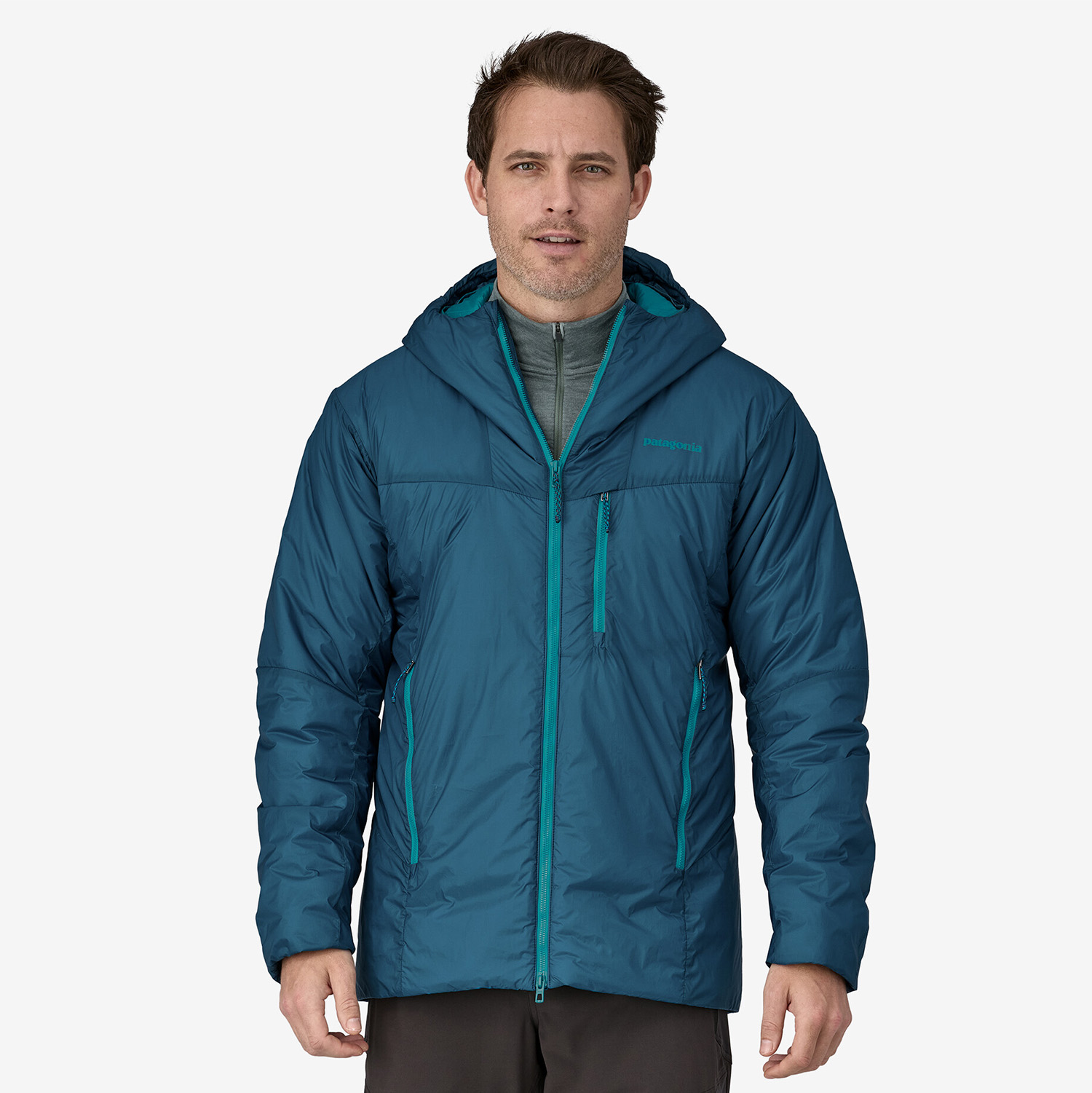
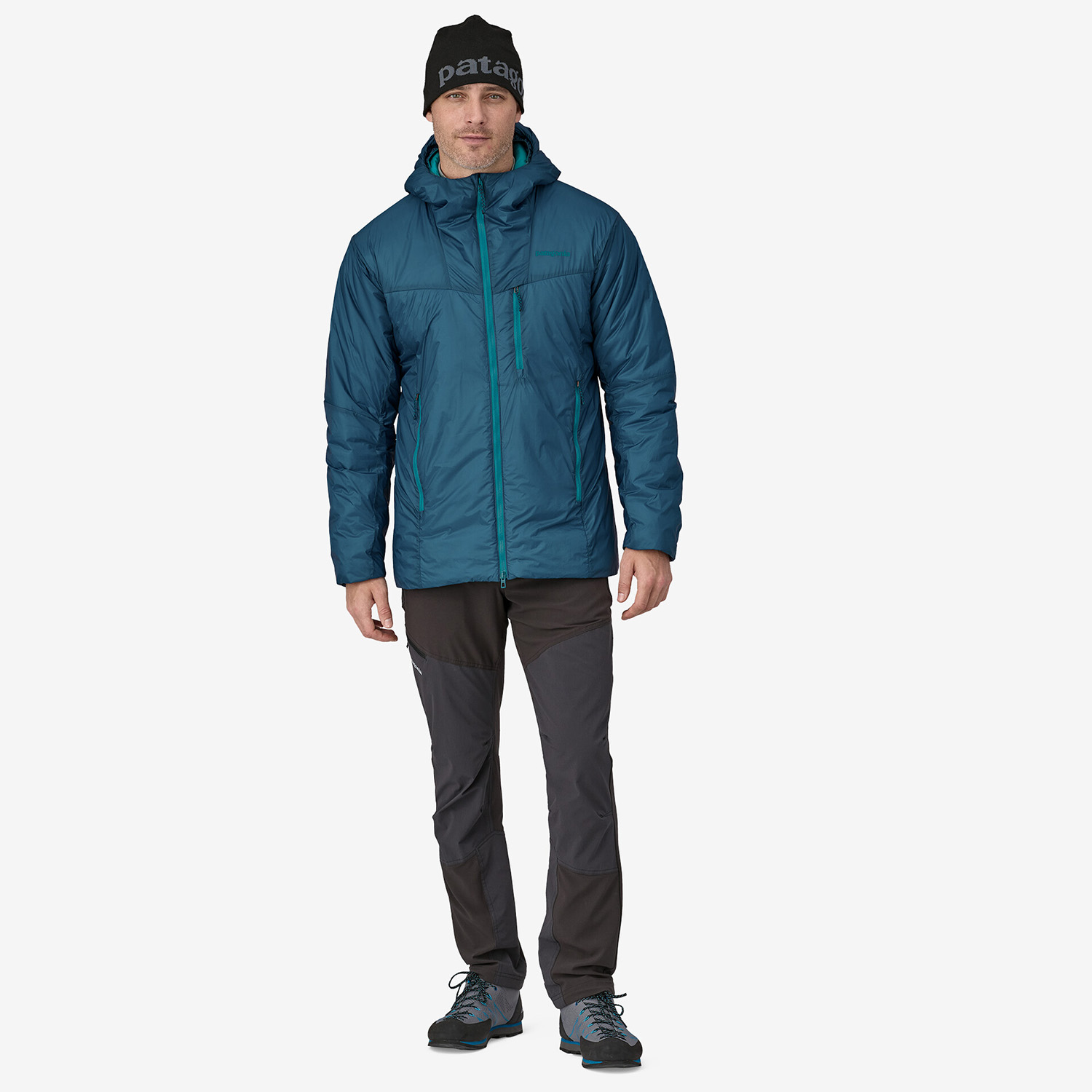

That 133-g insulation is already thicker and warmer than most of the layers here, but then around the core, Patagonia adds another layer of 40-g insulation for even more toasty-ness.
It’s not as mind-blowing to me as Patagonia’s PlumaFill insulation was when I first tried it, from a warmth-to-weight ratio, but I do think PrimaLoft’s Gold + Cross Core insulation is some of the best synthetic insulation I’ve used for bulkier, max-warmth pieces like the DAS Parka. I think high-fill-power down (800+) still has it beat from that perspective, but I don’t have to worry much about the synthetic DAS Parka getting wet, and that’s a big deal for me.
I don’t like worrying about getting my puffies wet, largely because they spend most of their lives stuffed into the bottom of my (often snow-filled) backpack, so I generally lean toward synthetic puffies for my preferences and where I recreate. Because of all that, the DAS Parka has been my go-to insulator for when I want something properly warm, rather than more typical “midlayer warmth” like the DAS Light Hoody. Plus, its fairly stiff and crinkly fabric is notably more water and wind-resistant than most “active insulation” layers’ fabric (most of which are more breathable and more supple), which adds to the DAS Parka’s versatility as an outer layer.
It’s overkill for many days, but if I want some extra peace of mind in the case of an emergency, the temperatures are very cold, or I know I’ll be sitting still for a while (e.g., camping), the DAS Parka is one of my go-to insulators.
Flylow Puffer Pant
MSRP: $150
Main Fabric: Furano Fleece (94% polyester / 6% Spandex)
Insulation: 40-g Greenloft synthetic (recycled)
Shell Fabric: Pertex Quantum (100% nylon)
Measured Weight: 373 g
Size Tested: Men’s Medium
Reviewer: Luke Koppa (5’8”, 155 lbs / 173 cm, 70 kg)
In general, my lower body is a lot less fussy when it comes to temperature than my upper body. Throughout most of the winter, I’ll happily ski in the resort and skin in the backcountry with just a lower baselayer and a pair of shell pants. However, we usually get 10-20 days each season at Crested Butte Mountain Resort where the temperatures stay in the single digits, or even sub-zero Farenheit (-12 to -18°C). And on those days, I definitely appreciate some extra insulation.
We talked in the past about the Strafe Alpha Insulator Short, which I still love. This season, I’ve been testing another insulated lower midlayer, the Flylow Puffer Pant. And especially recently, when temperatures have rarely been over 12°F (-11°C) for almost a week, it’s become one of my favorite pieces.
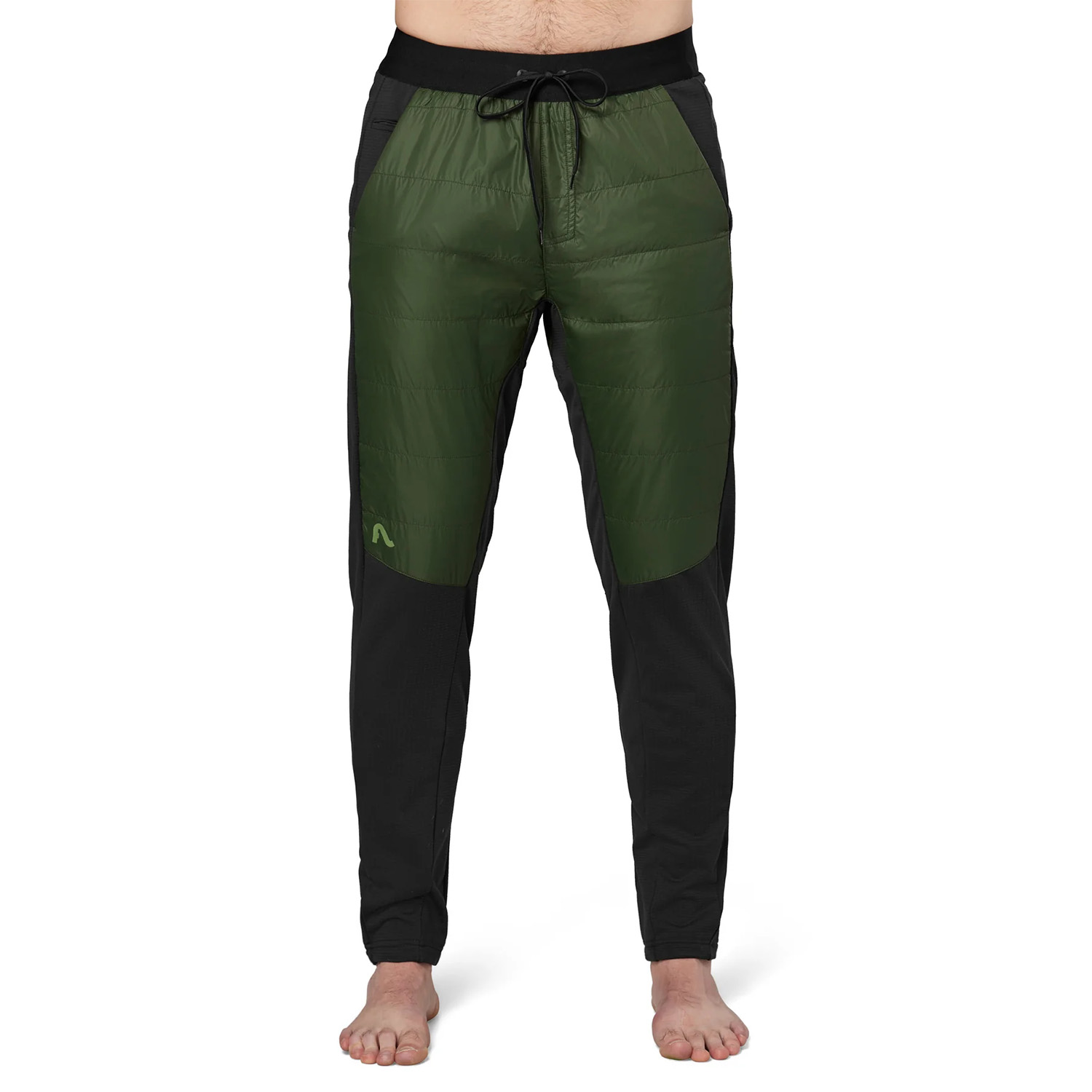
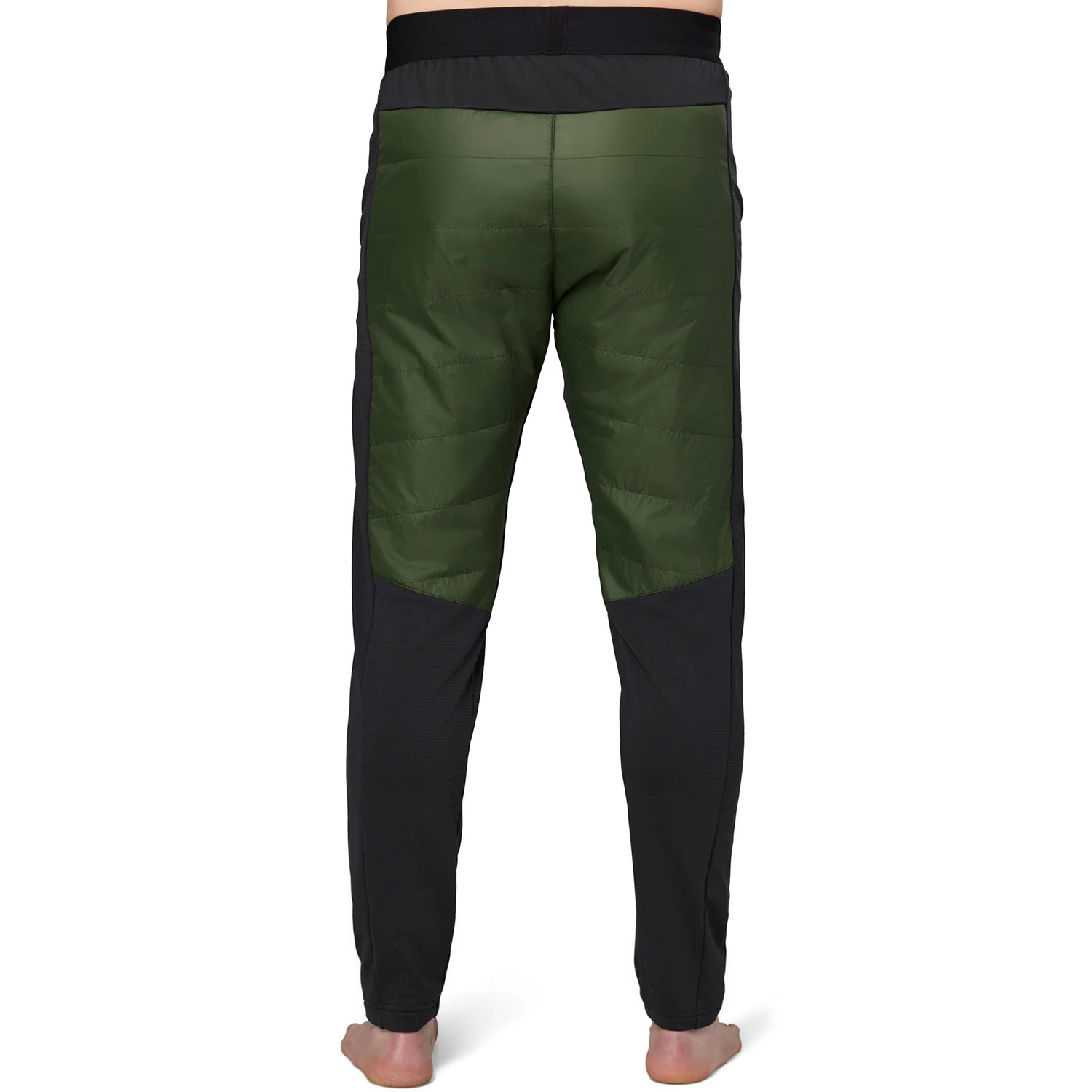
The Flylow Puffer Pant features panels of their recycled 40-g Greenloft synthetic insulation around the thighs / top part of the pant; the rest is comprised of their stretchy Furano Fleece. I’m a big fan of this layout since I’ll mostly be using the Puffer Pant with ski boots, and I don’t want or need a bunch of bulky insulation around my shins, since I’ll have to scrunch it above my boots anyway.
Speaking of, the Puffer Pant features a full-length leg, so I do need to fold and cuff it above my ski boots, but the lower fleece fabric is thin enough that I don’t notice that once I’m skiing. The fit is pretty slim overall, reminiscent of a jogger pant, but it hasn’t felt restrictive to me and is low-profile enough to work under most of my shell pants (it might be a tight fit if you have pants with very slim thighs).
The Puffer Pant also features two drop-in hand pockets, which are nice for lounging but otherwise go pretty much unused by me. It also features a drawstring waist, which is a feature I miss on the Strafe Alpha Insulator Short. The one complaint I have with Flylow’s Puffer Pant is the lack of a fly — there’s even sewing that suggests a fly, but no actual opening.
Otherwise, the Puffer Pant has been great for the cold resort days. I start to overheat in it once the temperatures climb into the high teens Farenheit (about -8°C), but have really appreciated it on our frigid mid-winter days. The Puffer Pant is worth a close look if you run cold and/or you prefer a layering system with an uninsulated shell pant but spend a lot of time in very cold weather.
Norrona Lyngen Alpha100 Zip Hood
MSRP: $349
Fabric: “aero100” (20D recycled nylon double-weave ripstop)
Insulation: 80-g Polartec Alpha (120-g at shoulders); 100% recycled polyester
Measured Weight: 374 g
Size Tested: Men’s Large
Reviewer: Jonathan Ellsworth (5’10”, 175 lbs / 178 cm, 79.5 kg):
The Lyngen Alpha100 Zip Hood uses a similar fabric layout as the Rab Vapour-Rise Summit and Outdoor Research Deviator Hoodie, with a tightly woven, lightweight face fabric and a high-loft fleece lining. However, the Lyngen Alpha100 falls on the more warm, less breathable, and more protective end of the spectrum, compared to those pieces.
The Lyngen Alpha100 still breathes notably better than traditional puffies, such as the Patagonia DAS Light and Outdoor Research SuperStrand LT, but similar to the Vapour-Rise Summit, the Lyngen Alpha100 sacrifices some high-output breathability in exchange for improved weather resistance over traditional fleeces (e.g., Patagonia R1 Air).
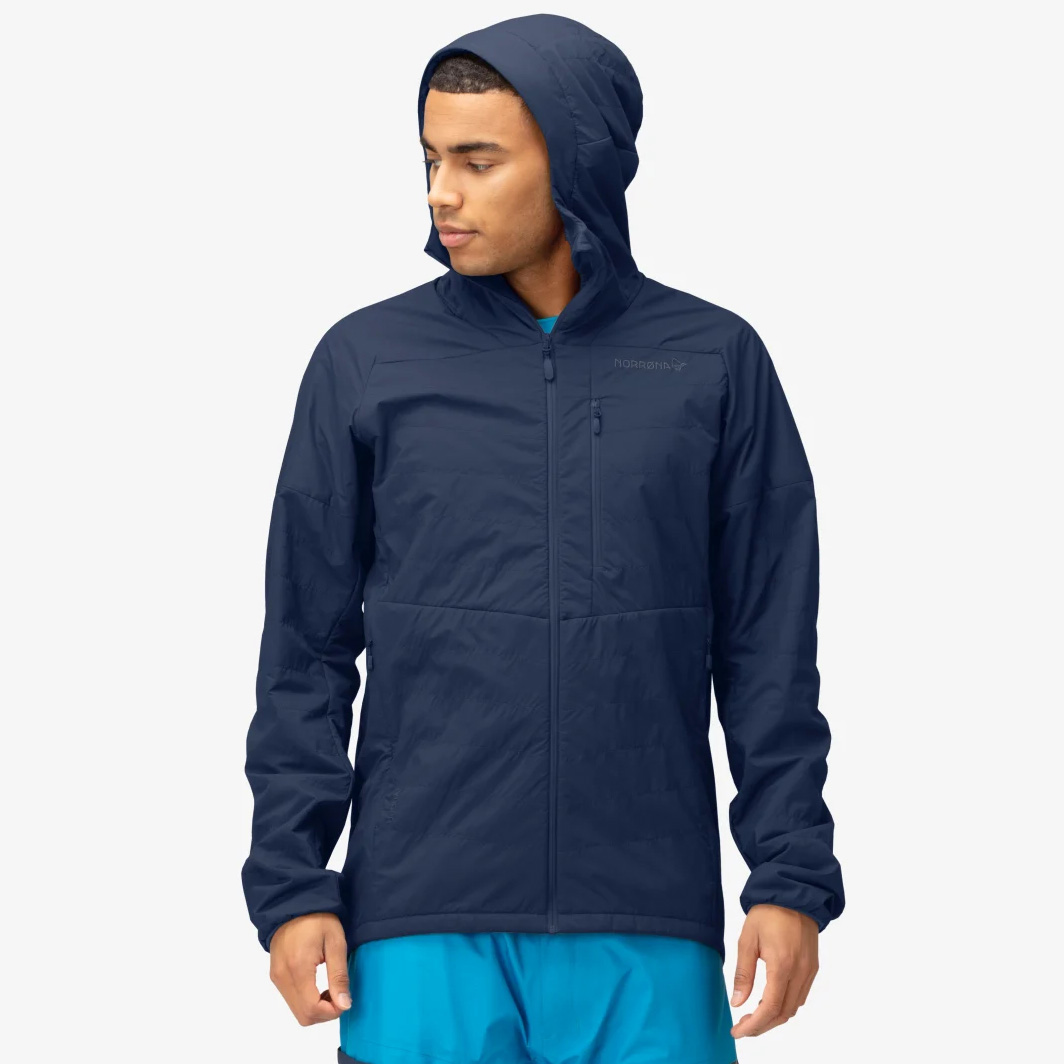
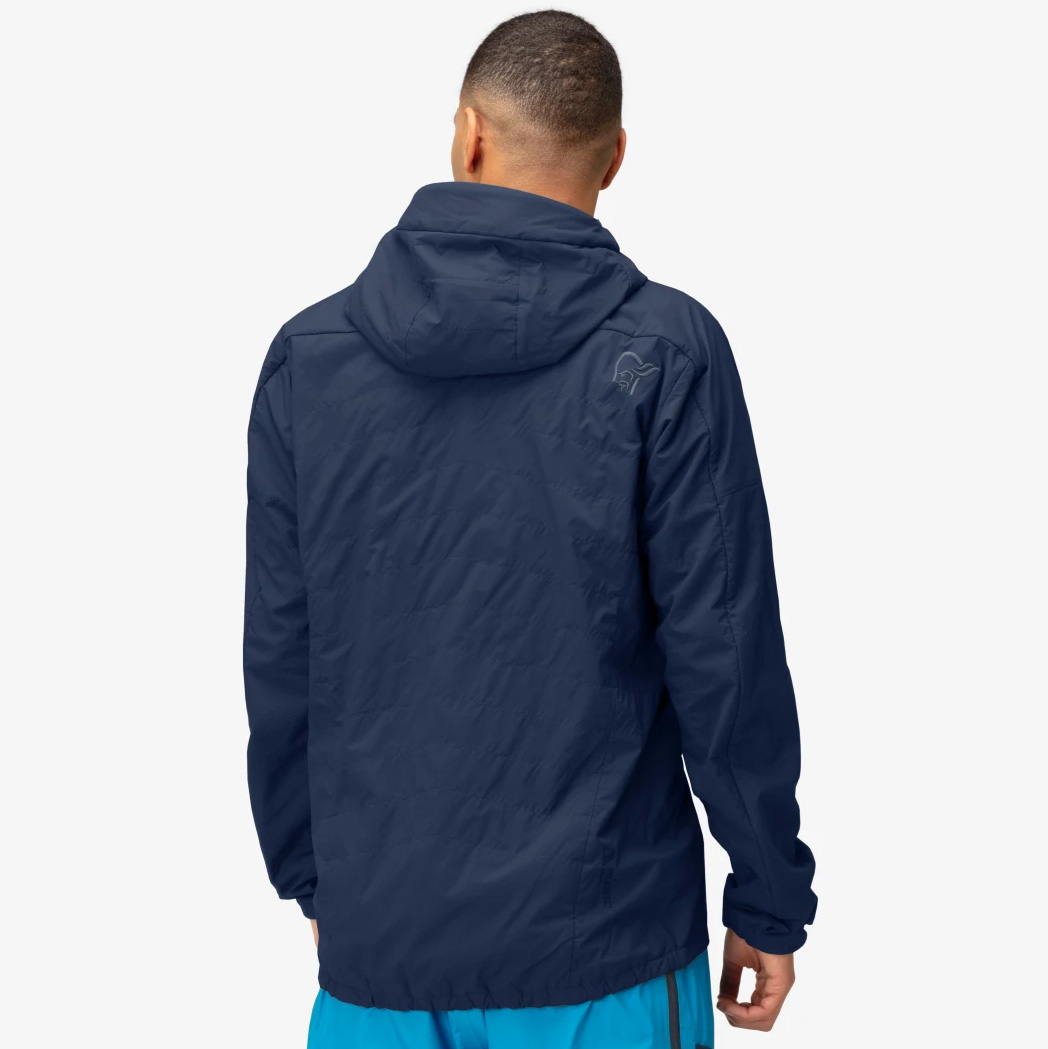
The Lyngen Alpha100’s face fabric is also surprisingly crinkly — not quite as much as the DAS Light and SuperStrand LT, but more so than most “active insulation” pieces, many of which feature stretchier, more supple, and quieter fabrics. This will probably be a non-issue for some folks, but might dissuade others.
In terms of fit, the Lyngen Alpha100 is a bit roomier than we expected from Norrona’s Lyngen line (their backcountry touring collection). It’s far from baggy, but we’d call it a pretty “regular” fit, whereas some other Norrona pieces we’ve used have been notably slim.
The Lyngen Alpha100 features Polartec’s 80-g Alpha insulation throughout most of the jacket, but swaps that for the 120-g version at the shoulders for added warmth and better durability when layering under backpack straps. All of this makes the Lyngen Alpha100 feel pretty similar to the Patagonia Nano-Air Hoody in terms of warmth and breathability, and a bit warmer and less breathable than the Rab Vapour-Rise Summit.
If you’re looking for maximum breathability and don’t need weather resistance, Norrona’s Falketind Alpha120 Zip Hood is a better choice — it doesn’t feature a separate face fabric and looks quite similar to Norrona’s Lofoten Alpha Raw Zip Hoodie we tested in the past. However, if you want a fairly warm midlayer that breathes better than average and still fends off light snow, the Lyngen Alpha100 Zip Hood is worth a close look.
Paka Apu Lightweight Puffer
MSRP: $279
Fabric: 20D stretch plain-weave (90% Nylon / 10% Spandex)
Insulation: 80-g PAKAFILL (60% Alpaca fiber / 40% polyester)
Measured Weight: 469 g
Size Tested: Men’s Medium
Reviewer: Luke Koppa (5’8”, 155 lbs / 173 cm, 70 kg)
The Paka Apu Lightweight Puffer is an outlier here, primarily due to its insulation. Rather than goose / duck down, various synthetic battings or fibers, or some sort of synthetic fleece, the Apu Lightweight Puffer uses Paka’s proprietary PAKAFILL insulation. In the case of this jacket, that means an 80-g batted insulation that’s 60% alpaca fiber and 40% polyester. We’ve previously seen other brands use various natural fibers in place of synthetics for batted insulations, but PAKAFILL is the first I’ve used that (1) uses alpaca wool as the primary material and (2) really competes with high-end synthetic insulations.
In use, I’ve found the Apu Lightweight Puffer a bit warmer than most similar-weight active insulators, such as the Patagonia Nano-Air Hoody and Rab Vapour-Rise Summit, especially when it’s windy.
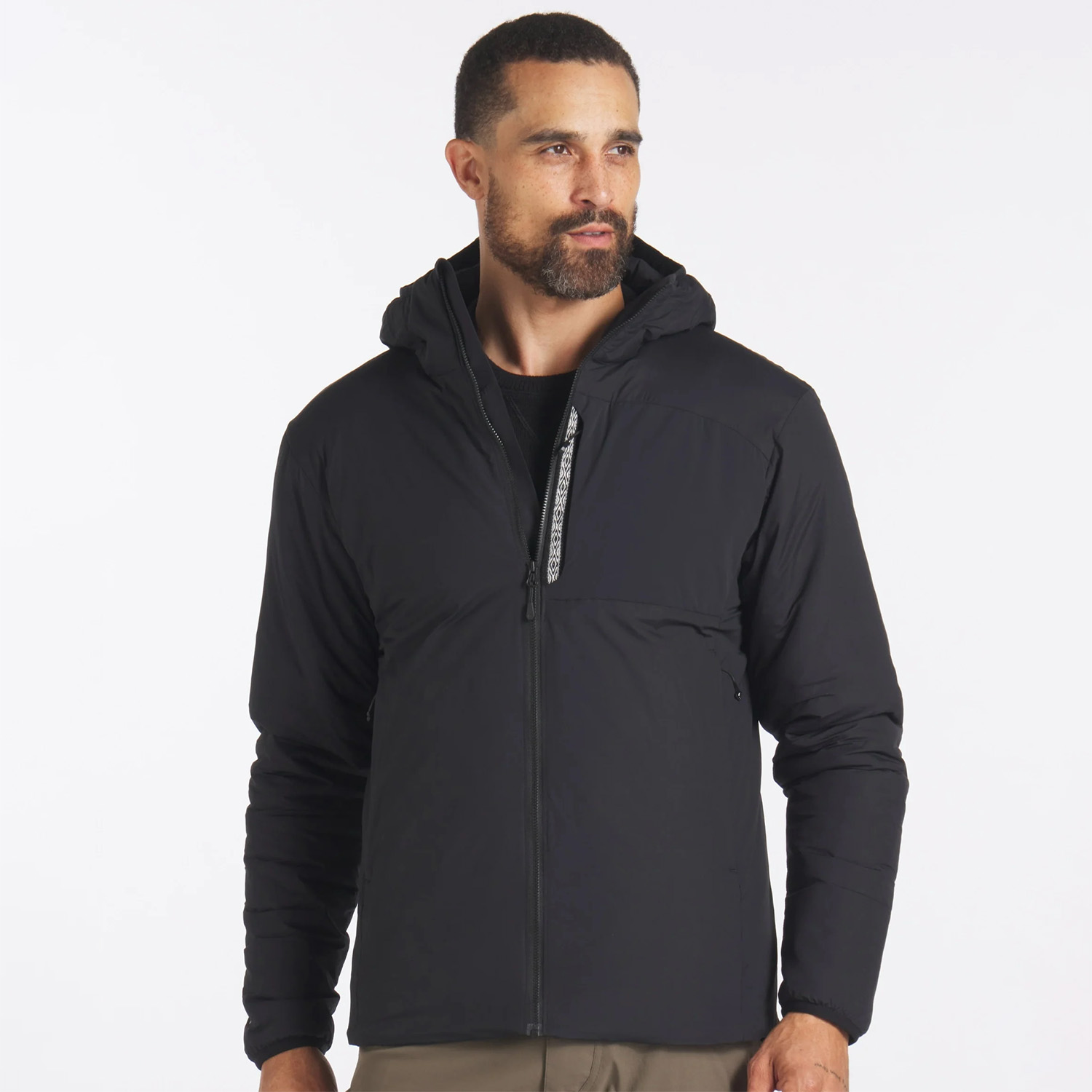
The Apu Lightweight Puffer feels notably less breathable than those pieces, but it’s a bit more wind and water resistant, and it’s still a bit more breathable than traditional puffies like the Patagonia DAS Light and Outdoor Research SuperStrand LT.
The Apu Lightweight Puffer is slightly on the heavier side of the spectrum for a midlayer, but it’s also a bit warmer than average for its size (its insulation is fairly low-profile), and it strikes a nice balance of being somewhat breathable and fairly weather resistant. Paka also states that PAKAFILL insulation keeps you warm when it gets wet (which checks out, given that it’s made of alpaca wool and polyester), and they have lots of info on their site about where their alpaca wool comes from, how it differs from sheep and goat wool, the people involved in their supply chain, and more.
The Apu Lightweight Puffer’s fit is pretty average for the midlayer category, if not maybe a touch slimmer than average. I wish the zipper guard at the chin worked a bit better and I think its shoulders could be patterned a bit better for range of motion when reaching up, but otherwise, it strikes me as a really well-executed midlayer — especially considering that Paka just got into outerwear this year.
In sum, the Apu Lightweight Puffer is worth a close look if you want a midlayer that’s warm for its size; a touch more breathable than traditional puffies; more weather resistant than many “active insulation” pieces; and that emphasizes ethics in both its materials and business model.
Norrona Lofoten Primaloft80 Anorak
MSRP: $399
Main Fabric: 30D ripstop Cordura nylon (100% recycled)
Reinforcements (shoulders, lower torso, & cuffs): 2L waterproof / breathable laminate
Insulation: 80-g Primaloft Gold w/ CrossCore
Measured Weight: 630 g
Size Tested: Men’s Medium
Reviewer: Luke Koppa (5’8”, 155 lbs / 173 cm, 70 kg)
I’ve been using the original Lofoten Primaloft80 Anorak for several seasons and it’s become one of my favorite insulation pieces for several scenarios. It’s one of the warmer layers here, utilizing 80-g PrimaLoft Gold w/ Cross Core, and featuring waterproof fabric over the shoulders, lower torso, and cuffs.
[Note: The original version I tested listed its 2L waterproof fabric as “Gore-Tex;” Norrona no longer specifies the type of waterproof fabric, but the current Lofoten Primaloft80 Anorak otherwise looks to be basically unchanged.]
The Lofoten Primaloft80 Anorak is one of my go-to jackets when I’m ski touring and want something quite warm that can also fend off some wind and water when worn as an outer layer.

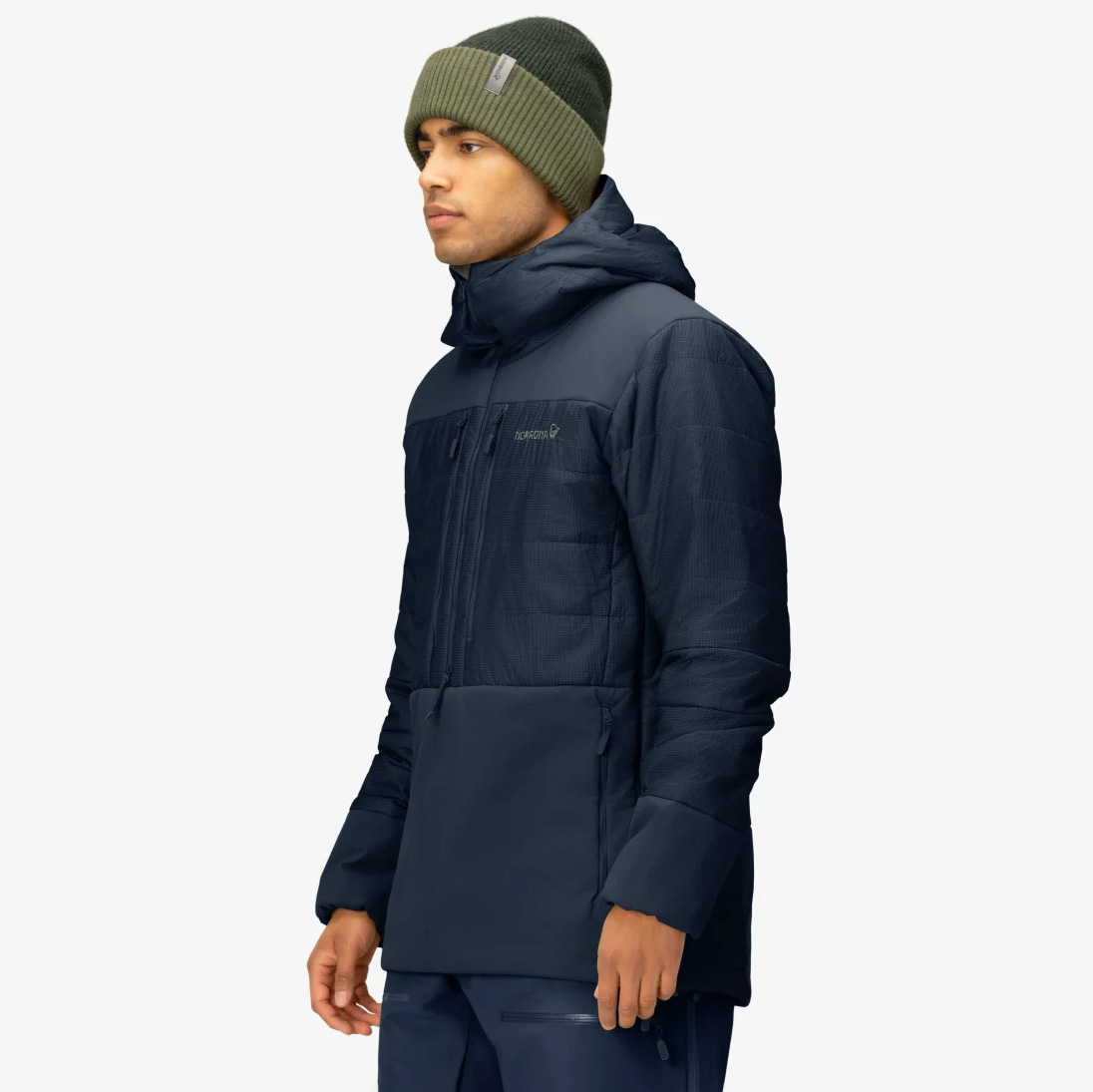

I.e., if my insulator for the day is also going to be my outer layer on the way down, the Lofoten Primaloft80 Anorak is one of my favorites. Compared to the other layers currently in rotation for that spot, the Lofoten Primaloft80 Anorak is notably bulkier and heavier than the Patagonia DAS Light Hoody. However, the Lofoten Primaloft80 Anorak is notably warmer, roomier, and more water resistant. Compared to the Patagonia DAS Parka, the Lofoten Primaloft80 Anorak isn’t quite as warm, it packs down to about the same size, and it’s more water resistant.
All of that makes the Lofoten Primaloft80 Anorak a bit of a niche piece on paper — it’s not the most packable, doesn’t have the best warmth-to-weight ratio, and it’s not fully waterproof. However, it gets decent marks in most of those categories, and as a result, I’ve found myself using it quite often.
In addition to serving as my insulator and outer layer for the descent while touring, I also just wear it around town a whole lot. It’s got a fairly standard cut in terms of roominess through the torso, but it’s longer than average through the hem and cuffs — a combo that I think looks very nice. I also like its high collar, which feels cozy whether I have the hood up or down.
The Lofoten Primaloft80 Anorak’s dual chest pockets are quite large and typically accessible with a pack, while its “kangaroo” lower pocket is nice for warming my hands. I also appreciate that the main zipper is two sided, so I can open the bottom to get stuff from my inner layers. It also features full zips on either side, which make it easier to get on / off and double as massive vents.
I won’t use the Lofoten Primaloft80 Anorak as my outer layer if it’s absolutely dumping snow (especially heavier snow), and it has limited capabilities as an actual midlayer since it’s pretty bulky (it does fit under my roomier shells). But if you want a puffy jacket that’s quite warm and more protective against wind and water than average, the Lofoten Primaloft80 Anorak could be the jacket you’ve been looking for.
Helly Hansen Lifaloft Air Jacket
MSRP: $300
Fabric: Pertex Quantum AIR 20D
Insulation: Lifaloft Air
Blister’s Measured Weight: 383 g
Size Tested: Men’s Medium
Reviewer: Jed Doane (6’2”, 160 lbs / 187 cm, 73 kg)
After a year, the Lifaloft Air Jacket is one of my favorite insulators. It’s a high-end active insulation piece that I wear for warmer days of lift-accessed riding and touring, and I’ve been impressed with how versatile it is in a range of uses and conditions. HH’s Lifaloft insulation is proprietary and designed in conjunction with Primaloft; it features a similar basic design to Polartec Alpha and other leading active insulation technologies, with a high-loft, fleece-like interior.
Recently, a windy day at Revelstoke presented a good test of this piece, with biting cold and wind throughout the day mixed with intermittent bootpacking. I was quite comfortable with a midweight merino baselayer, the Lifaloft Air jacket, and a 3L Gore-Tex Pro shell.
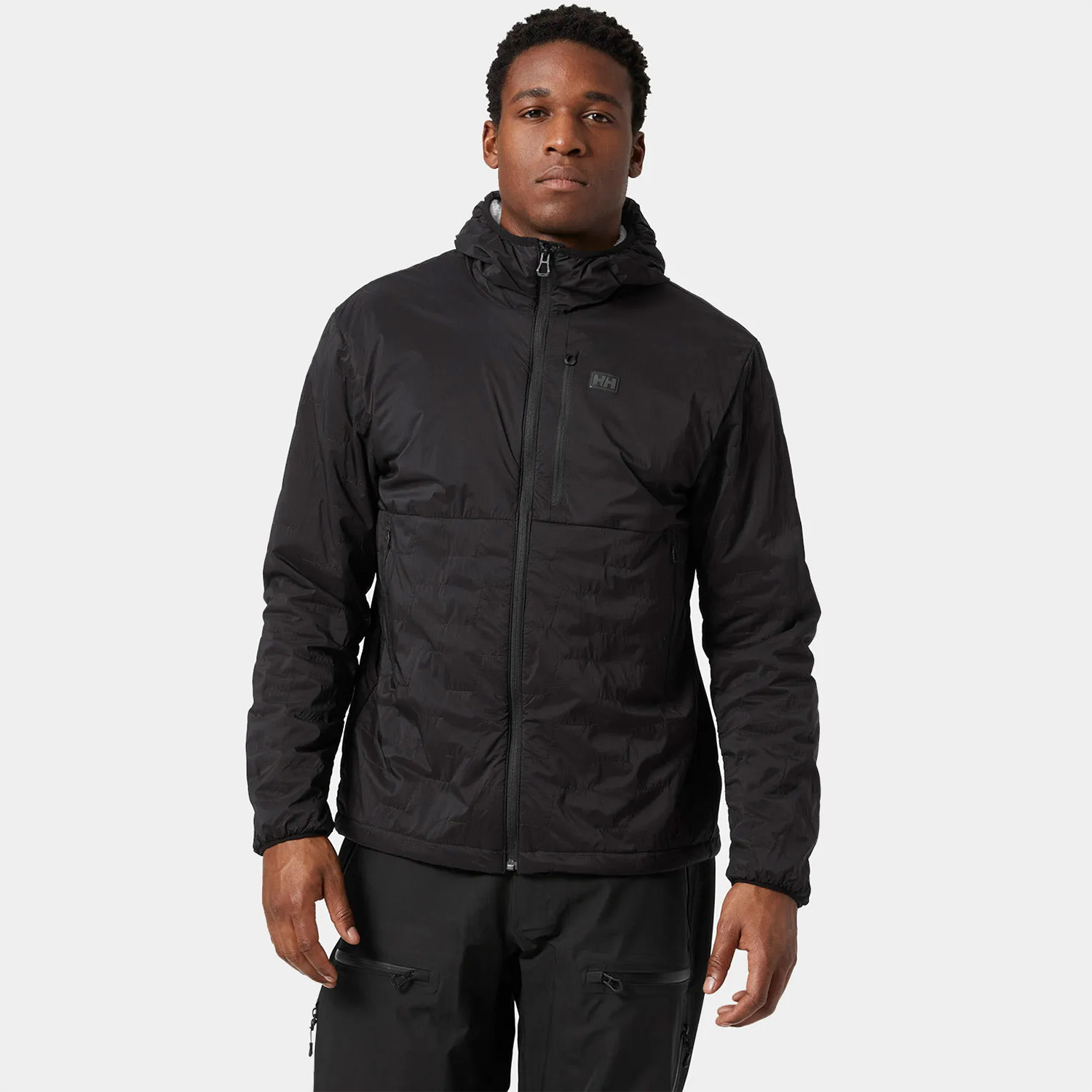
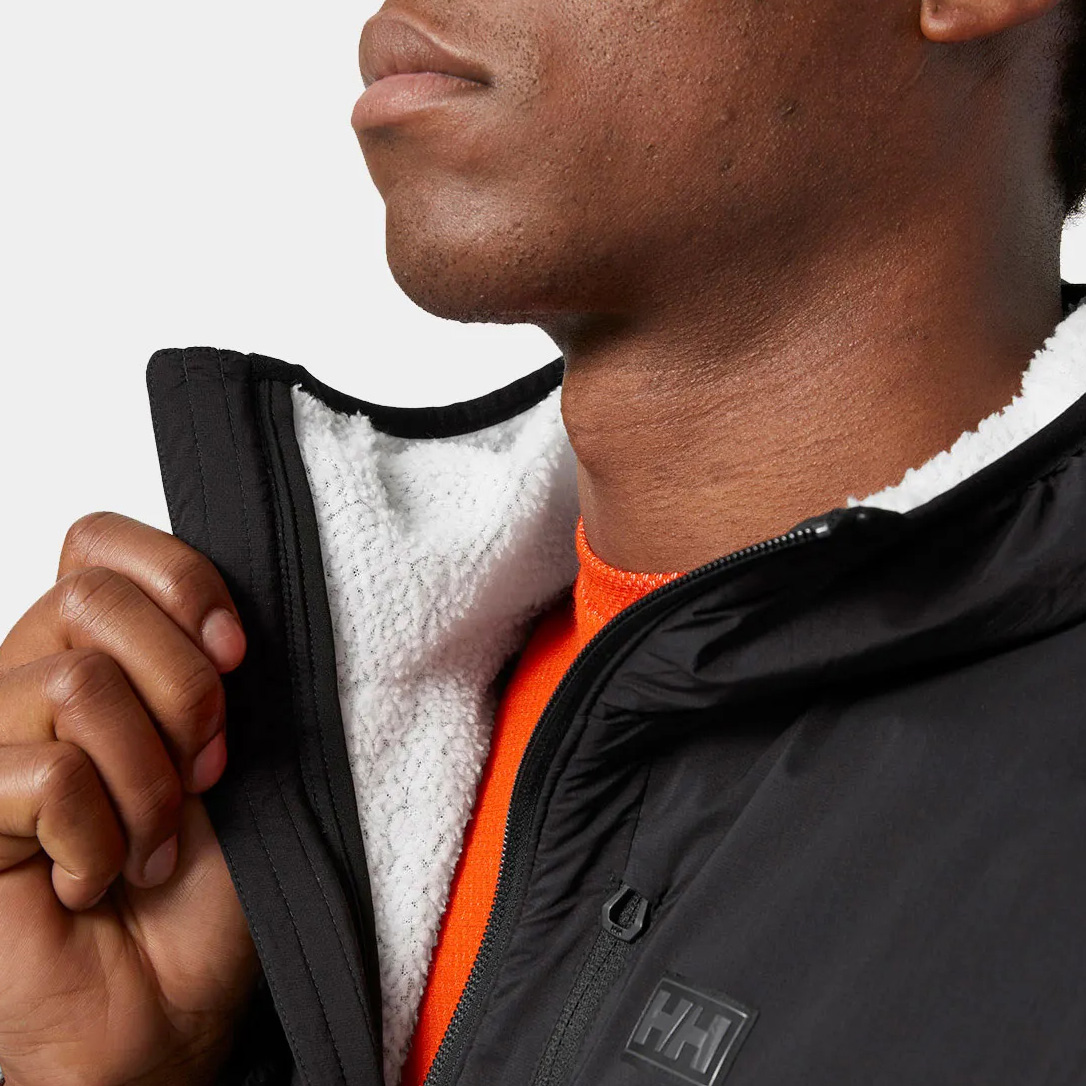

While touring in colder conditions, I find myself leaving it on most of the time and staying pretty comfortable with the temperature swings that come with changes in wind, exertion, and sun exposure. I found the wind resistance satisfactory and generally better than I’d expect with the level of breathability the Lifaloft Air jacket offers.
It’s designed with a nice slim fit with good stretch in the face fabric that makes it very easy to move in, which is especially appreciated when wearing a pack. The pockets are well-designed and lightweight — there’s a thin chest phone pocket and two handwarmer pockets that extend high enough to accommodate hands with a pack’s waist strap cinched. I appreciated the addition of a cord-adjustable waist and found the elastic hood and cuffs to work well. At a measured weight of 383 grams for a Men’s Medium, it’s pretty light considering its three-pocket design and relatively durable and stretchy face fabric, and is right in the middle of other active layers we’ve tested in terms of weight. I don’t take it off much, but it packs down to the size of a 1L Nalgene if needed.
Overall, the Lifaloft Air jacket is an excellent daily midlayer for ski / splitboard touring, offering excellent breathability during high-exertion states as well as better-than-expected warmth and windproofing. It’s the only midlayer I’ve reached for in the past several months.
Ibex Wool Aire Hoodie
MSRP: $285
Fabric: 20D nylon
Insulation: 80-g, 80% merino wool / 20% polyester
Blister’s Measured Weight: 323 g
Size Tested: Men’s Medium
Reviewer: Jed Doane (6’2”, 160 lbs / 187 cm, 73 kg)
Most midlayers on this page are composed of down or synthetic insulation, as has been the industry standard for decades. Ibex’s Wool Aire Hoodie, which utilizes a batted insulation primarily composed of merino wool fibers, is decidedly different — and is a great option among active insulators.
This is a surprisingly lightweight and breathable midlayer that has stayed in my active-insulator rotation for the past two years. Despite being extremely lightweight, it features zippered chest and hand warmer pockets while saving weight with elastic cuffs, hem, and hood. I’ve been continually impressed by the durability-to-weight ratio of its soft 20D nylon face fabric, which has held up well to many days on the skin track, trail, and around town.
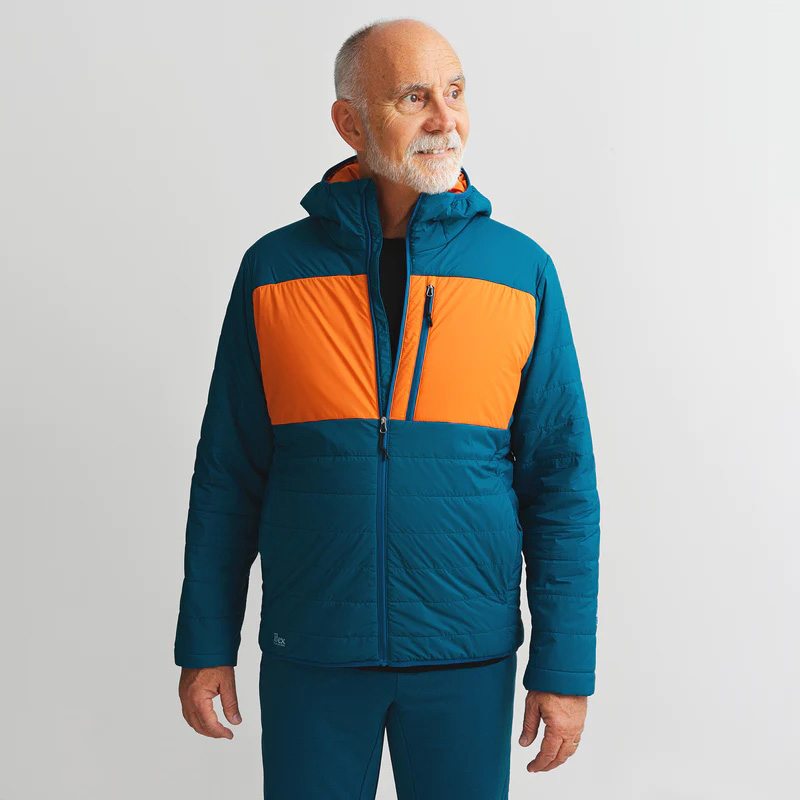

It’s not the most durable piece (as is the case with most lightweight insulators), but it hasn’t shown wear from pack straps or the occasional errant splitboard edge.
I’ve been very impressed by the Wool Aire Hoodie’s merino wool insulation. I’ve found it to be incredibly breathable and easy to move in, and the 80-g fill is a great weight for active winter pursuits and casual use in the shoulder seasons. It’s also more packable for the weight than other active insulators I’ve used, which definitely wasn’t the case with most batted-wool insulators from many years ago. I’ll sometimes bring the Wool Aire Hoodie as my midlayer on the coldest winter days and then toss on another light down jacket for transitions or lunch, but have found the Wool Aire Hoodie to be a versatile insulator overall. It’s remained stink-free after years of high-output pursuits, and I’ve only washed it in the machine a few times (another benefit of wool). The fit could generally be described as slim and long, though the generous stretch in the fabrics would likely allow for a comfortable fit with a variety of body shapes.
Obermeyer Klaus Down Hoody
MSRP: $319
Fabric: HydroBlock® Classic Toray® Airtastic™ 100% Nylon Ripstop Weave
Insulation: Allied Feather & Down 800 Fill Power DuckDown
Measured Weight: 412 g
Size Tested: Men’s Medium
Reviewer: Mark Danielson (6’2”, 205 lbs / 188 cm, 93 kg)
This is a fairly initial review, since I’ve so far only spent 6 days and nights testing the Obermeyer Klaus Down Hoody, but I figured I might as well weigh in with my first impressions. While it can be appropriate as an outer layer, I’ve worn it only as an insulated midlayer, under a separate outer layer.
First, I will clarify that the best size for me would be the Large, but the Medium that I’ve been testing has worked surprisingly well as a midlayer for my two uses so far: resort skiing and van-life sleeping on cold nights down to -3°F (-19°C). The sleeves of the Medium are short for me, but I’ve never noticed that while going to sleep, and my long ski gloves have compensated for that while skiing (not to mention my oversized hardshell ski jacket).
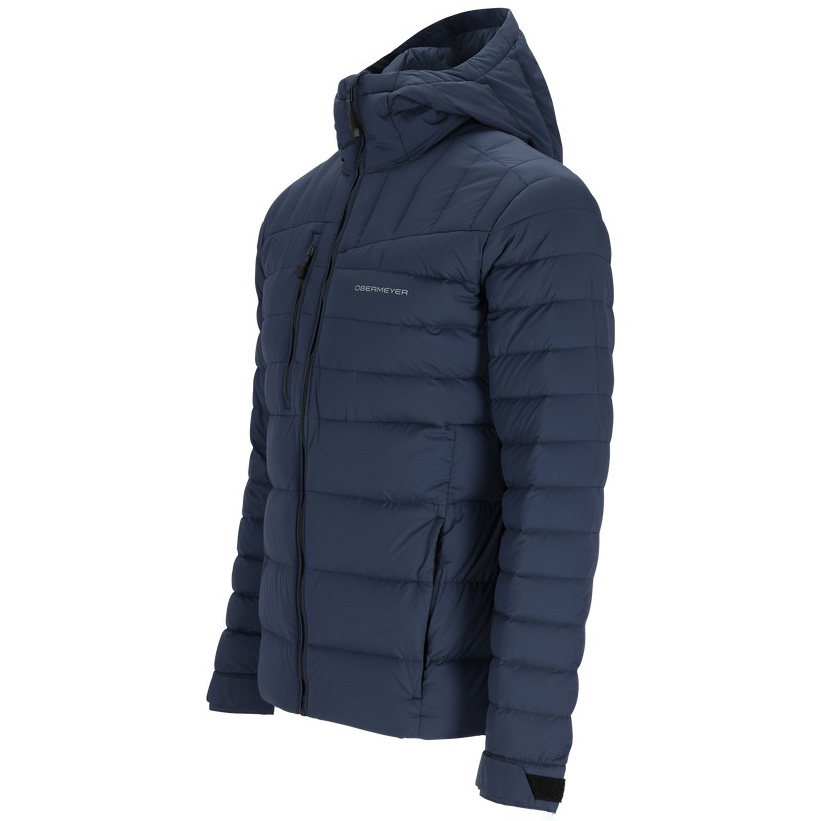
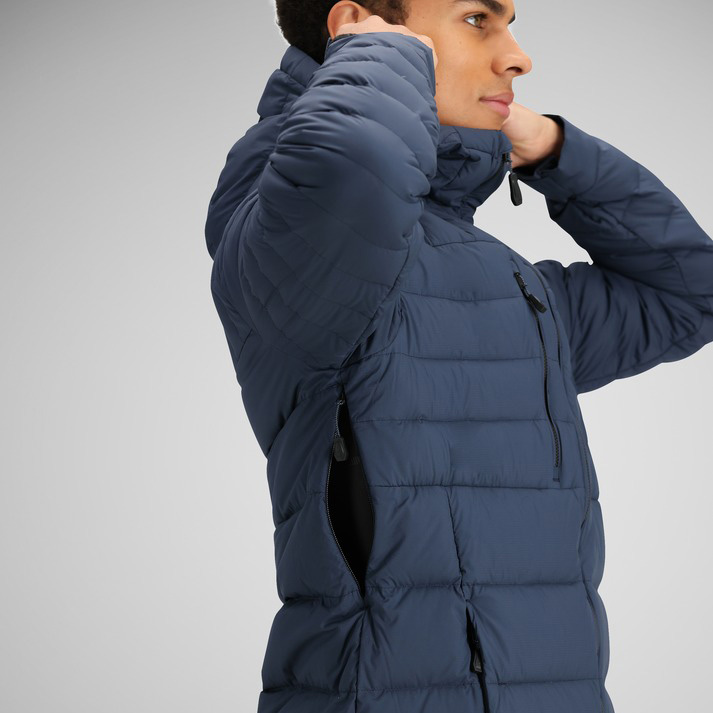
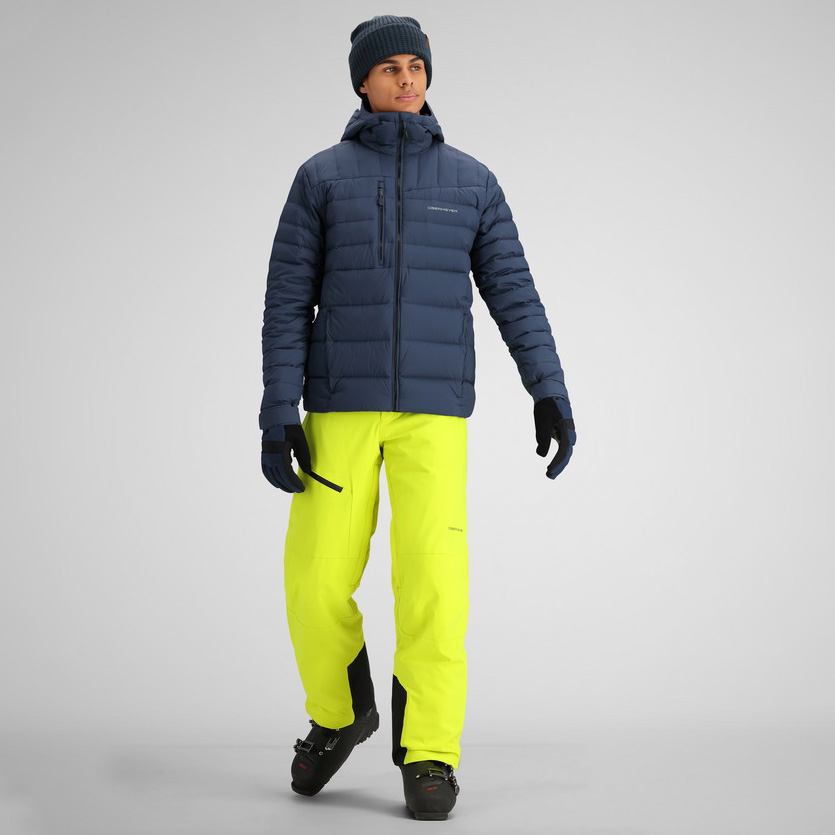

My original goal with this new down hoody was simple: Can I replace two outdated midlayers in my personal layering setups with this single puffy as an insulated midlayer? And the answer has been a clear “yes” for both resort skiing and winter car camping.
This light, soft puffy layers great under my hardshell for skiing, and also under my soft fleece coat at night. In both cases, the down keeps me warm, yet I feel like this puffy is barely there. I never feel anything bulky or stiff, not even the hoody’s adjustable velcro wrist cuffs, and not even if the hood somehow gets wadded up under my outer layer. As a midlayer, it’s usually covered up and out of sight — I just feel warm and forget about it completely, which is quite a compliment for the coldest days and nights.
The Obermeyer Klaus Down Hoody packs down to slightly bigger than a 1L Nalgene, and it has pit zips, but I haven’t yet tried any high-output activities to test its ventilation and breathability. What I can say is that I skied the resort hard enough one day to get me breathing hard for 3 full hours, and still the thought of overheating in the Obermeyer Klaus Down Hoody never even crossed my mind on that cold day.
This hoody also has many features that would make it a decent choice as an outer layer. It has two zippered hand pockets, two drop-in interior pockets, two zippered chest pockets (one exterior, one interior), a cinchable hem, and the aforementioned velcro wrist cuffs, hood, and pit zips.
Overall, the Klaus Down Hoody has made a good first impression on me. As an insulated midlayer, it is quite warm, soft, and forgettable (in a good way). It has successfully replaced two outdated layers in my personal setups for both resort skiing and van-life sleeping. Although it’s too early for me to call it my favorite or compare it to similar products in its class, I can already say it is a good all-round midlayer if you need something on the warmer end of the spectrum. And although I generally prefer a hoodless midlayer for resort skiing and winter car camping, if I had the Large size with its better fit for me, then I would likely also start wearing it as an outer layer and would occasionally enjoy using the hood.



wrt Luke’s “proprietary tech suspicions”, Patagonia appears to hold a patent on their quilting approach for PlumaFill but not on the yarn itself. The patent is US-11647801-B2, applied in 2014 and granted in 2023. Their white paper on the MicroPuff line also suggests that the stabilization was the tricky part: https://www.patagonia.com/stories/it-all-adds-up-to-nothing-forging-the-micro-puff/story-71152.html.
My reading of the patent claims is that OR could use a similar insulating yarn as long as they came up with a non-infringing method of stabilizing it.
From my own experience with patent filings, the structure of claim 1, and the 9-year delay from filing to grant, I suspect that the following happened: Patagonia initially applied for a much broader patent that covered both the yarn and the quilting independently. The examiner found prior art for the yarn, and they were forced to narrow the patent to cover their specific combination of the fiber/yarn and quilting. That in turn opens the door for other people to use similar yarns with different quilting.
Or OR could simply have licensed Patagonia’s solution. I’d have to have their jacket on-hand and compare it to the specific claims in the Patagonia patent, but nobody has time for that and I honestly don’t know enough about textiles to do a very good job (though I could probably do better than a certain judge in Waco. Cough).
Correction: Their patent granted in 2020, not 2023.
Ha, I appreciate the digging. Maybe if I happen to put a big enough hole in both I can put their insulation under a microscope…
I tend to run hot and value breathability above almost all else in a midlayer. Blister got me hooked on the Norrona Alpha Raw hoodie years ago, and that’s still my go-to in most conditions. It’s really only useful as a midlayer (it has no wind-resistance at all) but it really excels there.
It appears to live on in the form of the “Lyngen Alpha90 Jacket” and “Falketind Alpha 120 Zip Hood”.
Love these reviews but in this case there is a major omission. I believe a great many folks prefer a mid-layer without a hood .
How bout a part two with hood less equivalents?
I agree in several cases — fortunately, a few of these pieces do have hoodless equivalents that are essentially the same as the ones we’ve actually tested, except the hood. With a quick search, it looks like the following have hoodless equivalents: Outdoor Research SuperStrand LT Jacket, Patagonia R1 Air Jacket, Obermeyer Klaus Down Jacket. But as I noted in the Nano-Air writeup, I do wish pieces like that, which I almost exclusively use under another layer, were still available in hoodless versions.
Any recommendations for something really low-warmth and breathable without a hood? I tend to run hot and need to find something for resort skiing for when just a base layer under a shell isn’t enough but that won’t leave me sweating. I’m looking for the least warm, hoodless mid layer.
R1 Air 1/2 zip is probably the best bet for this that’s easy to find. I’ve really enjoyed the Senchi Designs Alpha 90 zip neck for this but it’s not often in stock.
That’s where the now-discontinued Norrona Lofoten Alpha Raw really works spectacularly well for me, though it has a hood. Previous Blister review here: https://blisterreview.com/gear-reviews/norrona-lofoten-alpha-raw-zip-hoodie. As the review says, it’s basically a made entirely out of loose-grid fleece with no face fabric. It really only works to its full insulation potential under a shell, but it’s basically “transparent” when it comes to breathability.
The “Norrona Lyngen Alpha90 Jacket” looks like exactly what you want – similar and similarly breathable design, 25% lighter grid insulation, and no hood. I have one on order and will update here when I get it.
The Arc’teryx Atom SL hoodie is my “go to” mid layer for ski touring & resort skiing as long as the temp is in double digits (Fahrenheit). It is also great for fly fishing, cold weather hiking, winter mountain biking (I live in SC) or just a good light breathable jacket for mildly cold weather or a drizzly day. I personally find the Atom LT and the original Patagonia Nano Air to be too warm for use as a mid layer unless the temp is down in single digits and the snow is blowing in sideways. Atom SL – Lightweight, packable, breathable, weather resistant, warm, but not too warm, and generally cozy. It checks all my boxes.
No mention of the Arc’teryx Proton jackets? To me they have the broadest sweetspot in terms of warmth / breathability / protection from elements.
Have been trying to test some of the Protons for a while now. Wasn’t able to make that happen this year, but hopefully in the future — they sound very intriguing.
It would be interesting to see you all test alpha direct over fishnet baselayers. I’ve been wearing alpha over brynje mesh for the last few seasons, and in my experience it works much better than the standard wicking approach. Sweat evaporates right off your skin, and the base and midlayer don’t retain moisture or wet out against your skin. It works even better with a thin hydrophilic layer between the alpha and the shell (assuming the shell is hydrophobic), since it sucks up all the moisture well away from your body and keeps the microclimate dry. I think alpha direct works better than alternatives like the r1 air/primaloft next/octayarn/etc. since those all retain a fair amount more moisture.
I used a rab alpha flash jacket for my midlayer last year but retired it into casual use this year as I found it to wear quite quickly and I’m actually one of those weirdos that wants a hooded midlayer in the resort and touring. I like the hood to add some extra head warmth for early mornings and for descents when skinning. I run very hot and typically hike for turns sometimes during my resort days, so breathability is key. My current quiver:
1. North Face Futurefleece full zip hoodie: I use this for resort skiing mid teens to mid 30s and backcountry touring in the single digits. It’s a super lightweight piece that is decently warm and very breathable
2. Ibex wool aire hoodie: goes in place of but sometimes over the North Face piece on the colder resort days and the truly frigid touring days
3. Norrona lofoten anorak mentioned above: Replaces my outer shell for night skiing and the most absolutely frigid resort days. I’ve had mine for years and it’s holding up great. I tried it for touring but found it too bulky/warm and hard to take off for most of my use
4. Arc’teryx nuclei fl: My main touring puffy. Very warm for the weight, easy on/off, packs down nicely, and has big interior dump pockets to rewarm frozen skins. Typically used only for breaks and rarely for the ride down
For bottoms I have both 3/4 merino tights (from some hunting brand) and the strafe insulated shorts. Full length zippers are a must here, these are great for days I am doing both resort and touring/sidecountry or for extra warmth on the truly frigid days